An In-Depth Guide To Inle Lake: Myanmar's Iconic Travel Destination

Our amazing Burmese adventure was nearing its end. We had deliberately left the best ‘till last and now it was time to make our way from the hill station of Kalaw to Inle Lake; our final destination.
Inle Lake is an incredible place; an expansive water body high above sea level, where pagoda spires gleam in the sunlight, Burmese fishermen row boats with one leg, local people grow fruits and vegetables in floating gardens and migratory birds amass in their thousands in the winter months.
The train journey from Kalaw to Shwenyaung (nearest railhead to Inle Lake) was spectacularly scenic and picturesque.
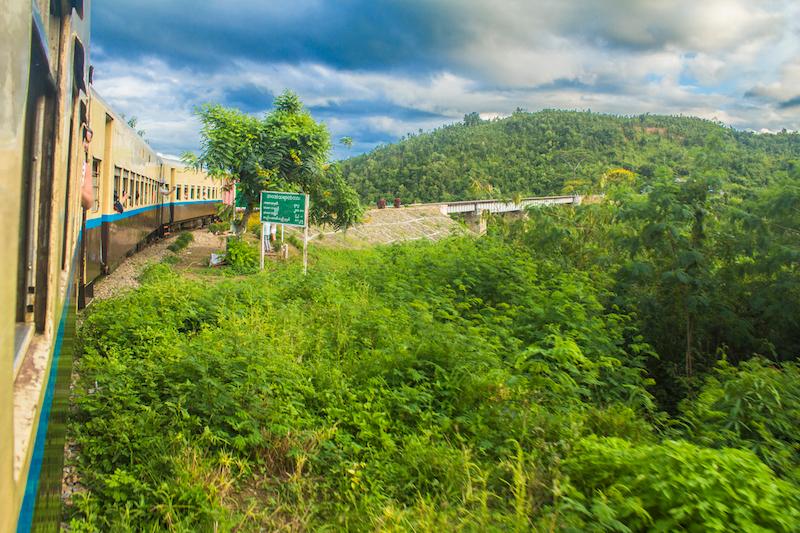
A pleasant cooling breeze billowed through the open train windows as the colorful undulating farmland rolled by.

Towering limestone rock outcrops would rear up alongside the tracks…..
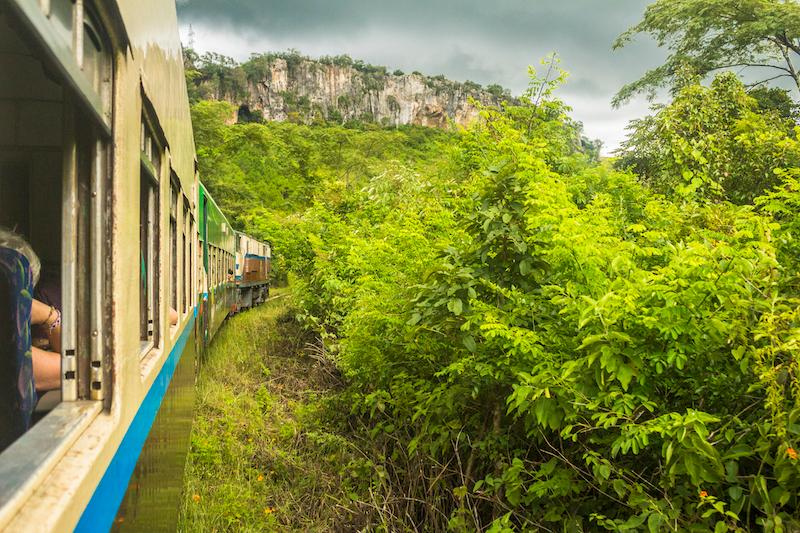
while swathes of beautiful Yellow Cosmos (Cosmos sulphureus) flowers nodded their heads within arm’s reach of the passing train.

3.5 hours later and 50km from Kalaw, we finally arrived in Shwenyaung railway station. From here it was only a matter of hitching a ride for the remaining 12 km between here and Nyaungshwe, the base town for exploring Inle Lake. It was growing late in the evening and a moto driver in Shwenyaung offered to take us for a reasonable price, so we agreed.
We were however, not foolish enough to continue all the way to Nyaungshwe on the motorcycle taxi. Most tourists get caught out on the main road into Inle Lake with the entrance fee trap. It’s a substantial fee too; 12,500 kyat or almost $11.
We dismounted the motorcycle some distance before the main tollbooth, paid the driver and soon flagged down a car with two young Burmese guys sitting in the front seats. While laying low in the back seat, the car sailed past the tourist tollbooth and so we managed to avoid the entrance fee scam. Our mission had been a success; we had managed to reach Inle lake without getting scammed.
Location
.png)
Myanmar’s Inle Lake lies at an elevation of 880m (2,900ft) above sea level and is located in the Shan hills of Taunggyi District in Shan state. It’s 639km north of Yangon by road and 313km south of Yangon. It’s about 323km southeast of Bagan (Nyaung U). The popular hill station of Kalaw lies about 71km to the west by road.
Getting there
When travelling to Inle Lake, you will probably want to head for the town of Nyaung Shwe lying just to the north of the actual lake itself, where the overwhelming majority of guesthouses, hotels, restaurants, shops and other facilities are found.
By train:
We travelled to Nyaung Shwe by train from Kalaw, which is a hill town found 70 km northwest of the lake. In fact, we first took the train to Shwe Nyaung, which is the nearest railhead for Inle Lake and from Shwe Nyaung, we were able to hire a motorcycle taxi to take us the remaining 13 km to Nyaung Shwe. It's also possible to reach Shwe Nyaung by train from Yangon or Thazi.
By bus:
Train journeys in Burma are a worthwhile experience in themselves and parts of this journey are very picturesque, but if you can't tolerate the slowness of the train (the journey by train from Yangon could take 30 hours vs only 12 hours by bus), Nyaung Shwe can be reached directly by bus from Yangon, Mandalay, Kalaw and even from Hsipaw.
By air:
The nearest airport is in Heho, about 32 km northwest of the lake, but from there you'll have to take an expensive 1-hour taxi ride to Nyaung Shwe. It's possible to split the costs if you can find other travellers to share with.
The cheapest option: The train, especially if you're willing to buy an ordinary class ticket (wooden seats). You can then hitchhike, catch a songthaew or hire a motorcycle taxi from Shwe Nyaung to Nyaung Shwe.
If you need more detailed transport information on getting to Inle Lake, check out this guide by Wikitravel.
If you wish to book a bus to Nyaung Shwe or a train to Shwe Nyaung, we recommend doing so with 12Go.
Enter your origin, destination and date of travel into the form below to find out what your options are:
When to visit
The peak time to visit Inle lake is from October to February for a couple of reasons. Firstly, it’s the dry season so there’s a lower chance of having your trip spoiled by rainy weather. Secondly, it’s cooler during this period and especially so at night or in the early hours of the morning.
The famous Phaung Daw Oo pagoda festival also occurs around the beginning of September or the start of October, which makes a boat trip on the lake a lot more eventful, exciting and worthwhile. We caught the start of the festival on the 12th of October and we’ve written all about it below.
This is also the best time for birdwatching, especially from November onwards, because of the influx of thousands of migrants. Arrive too late however and you’ll only be left with seagulls.
Some background info about Inle lake
Inle lake measures about 22km in length by 10km in width, although practically it’s hard to determine the true boundaries of the lake because of all the marshland surrounding it. The total surface area of the lake is 116.3 square kilometres, making it the second largest lake in Myanmar (the largest is Indawgyi lake).
The main watershed area of the lake lies chiefly to the north and northwest of the lake with the Nam Pilu River being the primary outflow at the lake’s south end.
The lake is surprisingly shallow, with depths averaging about 2.1m (7 feet) in the dry season and increasing by about 5 feet during the wet season. The lake reaches maximum depths of about 3.7m in the dry season and about 5.2m in the wet season (+5 feet).
Climate
The climate at Inle lake is monsoonal with the wettest period being from May to September, although rainfall is still quite frequent during the dry season on the Shan plateau and more so here than in any other place in Burma. The average annual rainfall is 1,370mm.
The hottest months are March-May, when temperatures can often reach 30°C during the daytime. Night temperatures fall much lower during the months outside the monsoon season, often falling below 10°C during these months. The average annual temperature is 26°C.
Wildlife and environment
Inle lake is actually a wetland wildlife sanctuary and was recently inscribed as Myanmar’s first UNESCO biosphere reserve.
The lake is notable for its high number of endemic species, which is unusual for a lake of its size. For example, the habitat is home to twenty-odd species of snails and nine species of fish that are found nowhere else in the world.
Endemic fish include the Inle Swamp Eel (Chaudhuria caudata) and the Inle Snakehead (Channa harcourtbutleri).Other endemic fish found in the lake like the Lake Inle Danio (Devario auropurpureus), the Crossbanded Danio (Danio erythromicron) and the Inle barb (Sawbwa resplendens) are of minor commercial importance as aquarium pets.
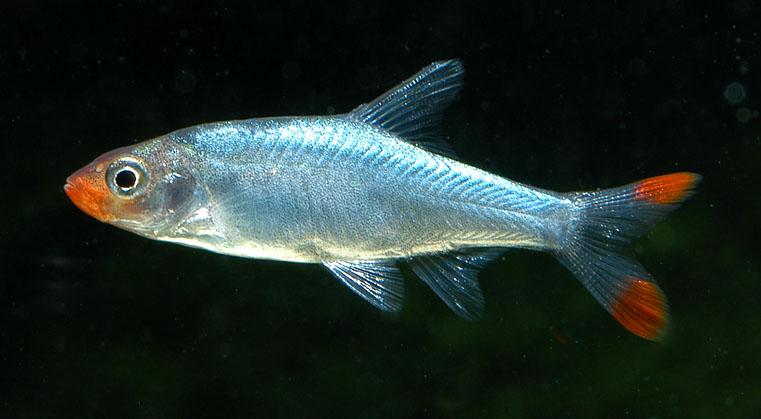
The lake is also a paradise for birdwatchers, especially in wintertime (November-March), when it receives a large influx of migrants, mostly coming from China and Mongolia. The 20,000+ winter visitors mostly consist of brown and black-headed seagulls but there are also many other rarer species to be spotted among them.
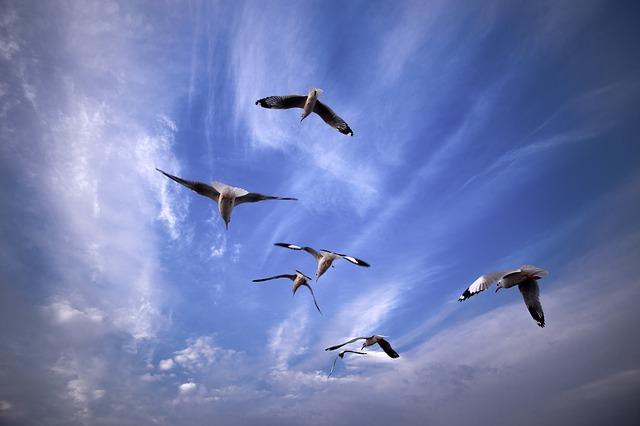
In total the sanctuary has recorded 255 woodland birds and 90 wetland bird species. Reports have also come in that the world’s tallest flying bird - the globally endangered Sarus Crane (Grus antigone) is nesting within the sanctuary.
-_In_Display_near_Hodal_I_Picture_2036.jpeg)
People
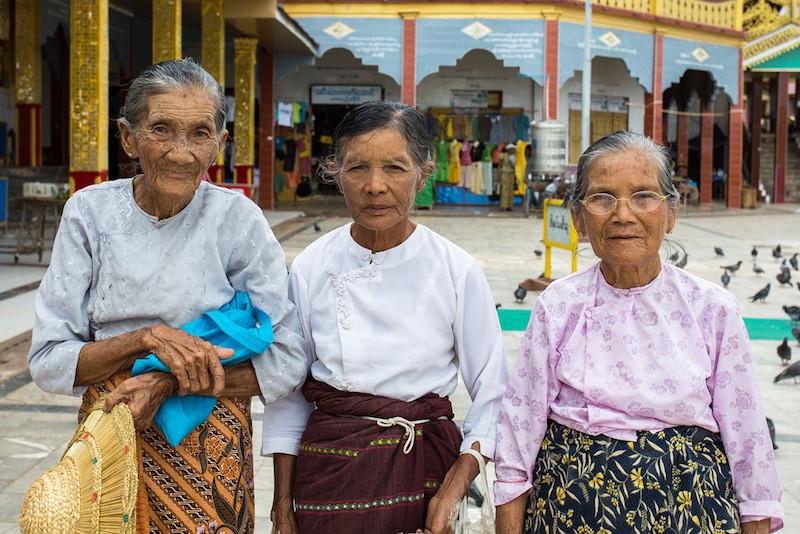
The majority people of Inle Lake are known as the Intha and they number about 70,000, with their population distributed among the towns and villages around the lake and also on the lake itself in their traditional wood and bamboo stilt houses. Other ethnic groups residing in the area include the Shan, Taungyo, Pah-O (Taungthu), Danu, Kayah, Danaw and the Bamar.
Since waterways replace roads on the lake, the people get around in small hand-rowed wooden boats or larger boats powered by inboard diesel engines.
The Intha fishermen are famous for their unique technique of rowing their boats with one leg while balancing (standing) at the tip of the boat’s bow on the other leg. It's an unusual but highly practical boat rowing method on the lake where visibility is greatly limited by high reeds and water vegetation.
The fishermen also carry large conical nets supported by a bamboo or cane framework for trapping fish and these are understandably much easier to manage when both hands are free. Hence the leg rowing technique serves a dual purpose.
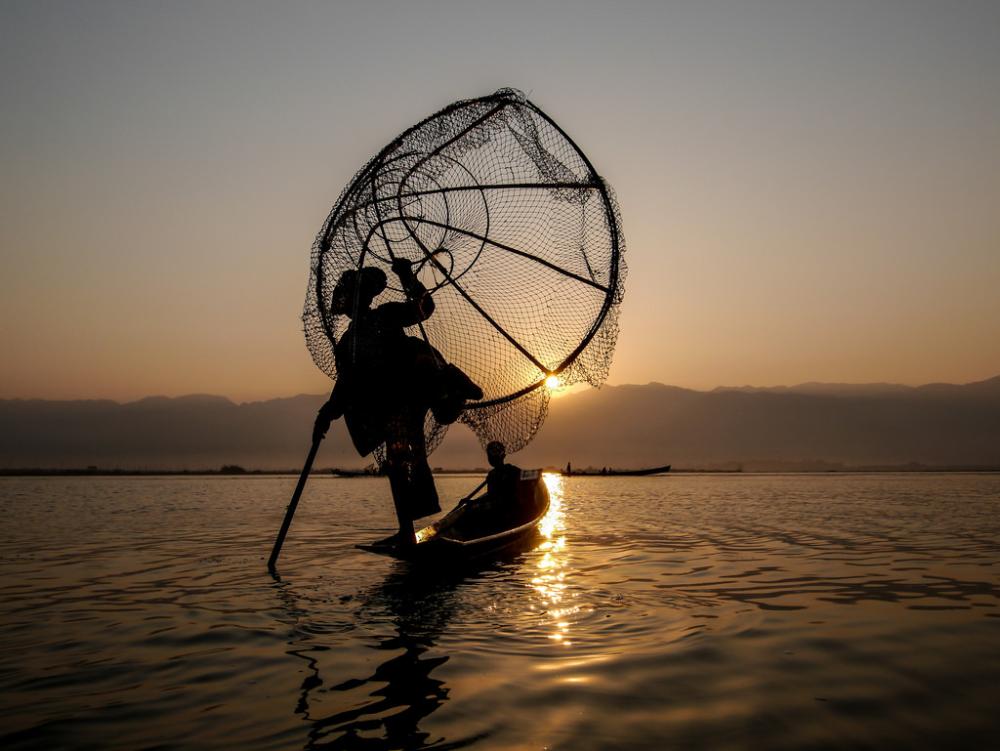
To catch fish, the fishermen will first submerge the nets and then hold them down against the lake bed with their feet, thus trapping any fish that are hiding among the weeds below. This is only possible of course because the lake is so shallow.
Once the net is in place and the fish are trapped, the fishermen then spear blindly at the fish through an opening at the top of the cone, using a long sharpened stick. This panics the fish and in attempting to escape from the jabs of the spear they get snagged by the gills in the net.
The technique is passed down from generation to generation and boys begin learning it from the age of 13 and continue fishing with this method up until a ripe old age. The method takes years of practice to fully master and is very difficult to learn. The womenfolk however don’t use this technique and just row the boats normally with their hands while seated.
With necessity being the mother of invention, the people have developed floating gardens on the lake, where they can grow an impressive range of fruits and vegetables, although tomatoes are the predominant crop.
The tomatoes here are big and juicy (thanks to chemical fertilizers) and are used to make a delicious local tomato salad. Squash, cucumbers and pulses are also grown depending on the season but the floating gardens aren't suitable for growing root vegetables.
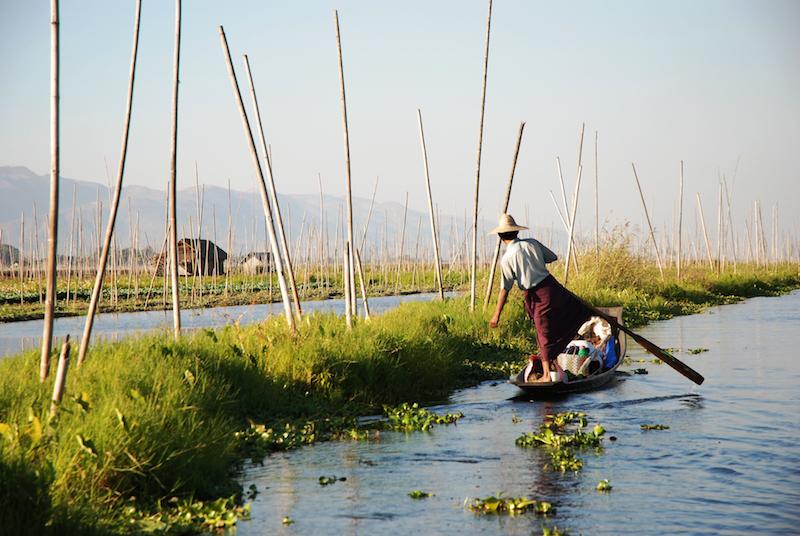
To begin the creation of the floating gardens, clumps of water hyacinth and other lake debris are heaped into long floating rafts and allowed time to knit together. Bamboo poles are driven through the rafts and down into the mud at the bottom of the lake to anchor the whole thing in place.
Grass is encouraged to grow on the developing rafts and this is eventually cut, dried and burned to create an ash fertilizer for the garden. More weeds and a thin layer of mud from the lakebed are scooped up and spread onto the rafts to further consolidate them. The rafts eventually reach one metre in thickness with about two thirds of that below the water.
With constant access to nutrient-laden water, the end result is a highly fertile floating garden that rises and falls with the changing water level of the lake, making it immune to flooding. The overall layout of the gardens is very practical, with waterways left between the floating rafts to allow the gardens to be easily accessed and tended to from boats.
.jpeg)
Other than subsisting on lake-grown fruits and vegetables, the local people also cultivate a lot of rice in the paddy fields surrounding the lake.
Predictably, fish also features heavily on the menu, with the most commonly eaten fish being the Inle carp (Cyprinus intha), known locally as nga hpein. The fish is a dietary staple but has declined in numbers over the past few years, possibly due to pollution.
Handicraft is an important mainstay of the local economy and many beautiful woodcarvings, smoking pipes, ornaments, textiles, cheroots (leaf-rolled cigars) and other handmade items are created in cottage industries to be sold at both local and tourist-oriented markets.
Weaving is a major local industry and Shan bags are produced in large quantites for daily use. The lake is also famous for the Inle longyi , a fine garment hand-woven from silk fibres. A very exquisite garment called the kya thingahn is woven from the fibres of the lotus plant and used as a robe for sacred Buddha images.
Tourism is playing an ever-increasing role in the local economy with Inle Lake now receiving over 100,000 visitors per year. That said, the majority of people in the region still depend on farming and fishing as their mainstay.
While tourism has benefited some people with increased wages, it has had some negative consequences for many of the poorer people in the region who still depend on the land to earn a living.
Some farmers have lost their plots of land to new roads and hotel developments, receiving only a small amount of financial compensation in return. Many of the Intha fishermen also find tourists a disturbing element on the lake, although some of them now also take advantage of tourists to earn tips.
Environmental problems facing the lake
Although all might seem to be well with the lake, at least superficially, there are in fact several serious problems facing the lake and the ecosystem associated with it. The Government have so far failed to address any of these problems and are seemingly only interested in continuing to exploit the lake's revenue potential.
Lake shrinkage
One problem the lake is facing is dramatic shrinkage of its net open water area, which decreased by 32.5% during the period from 1935 to 2000. That's almost one-third of the entire lake.
The loss of area has been strongly linked to the introduction of the floating gardens in the 1960s, which are mostly confined to the west side of the lake and are now said to cover 25% of the lake's total surface area. The problem is that the gardens eventually solid ground over time and hence they contribute to the shrinkage of the lake.
Climate change is another factor that has been blamed for the shrinkage of the lake and falling water levels, with the area receiving poor amounts of rainfall over the last few decades.
The lake is also silting up, which is another reason for the shrinkage of the lake. The problem is connected to forest clearance up on the hill slopes in the main watershed area of the lake.
Poor village communities have to clear the upland forests for firewood and to grow more crops for their expanding populations. The loosened soil is then eventually washed into the lake by streams and rivers, which makes the lake shallower and causes water loss. Additionally, excessive silt makes the water murkier and warmer, which can wreak havoc with the entire ecosystem.
Pollution
Inle lake has become quite polluted from a variety of different contaminants that are finding their way into the lake.
Sewage run-off into the lake from local homes is one such pollutant. Most toilets are open-pits and human waste just gets piped directly in the lake.
Toxic waste from a huge open cast lignite coal mine and the nearby Tigyit coal power plant, located within the lake's watershed just 13 miles away, is also finding its way into the lake via the Balu creek tributary, the lake's biggest water source.
Farmers are also using tremendous amounts of chemical fertilizers and pesticides on their floating gardens to produce bigger and better tomatoes and other crops. The vegetables have to be big and juicy looking to sell in the markets.
However, these chemicals find their way into the lake and increase levels of phosphates and nitrates, leading in turn to the proliferation of algae (algal blooms) and of invasive plants like water hyacinth (Eichhornia crassipes).
These outbreaks of algae and invasive plants can lead to low dissolved oxygen levels and reduced light availability for native aquatic plants, causing a collapse of the entire food chain, meaning that ultimately the fish that the people depend on may all die. In fact, fish numbers in the lake have declined considerably over the past few decades. These days, fishermen can often spend hours out on the lake without catching a single fish.
Regarding the water quality, some studies that have been carried out on the lake have suggested that the lake water is unfit for human consumption due to unacceptably high levels of pollutants.
Invasive species
As we touched upon briefly above, alien plant and animal species are another problem facing the lake, with the most problematic alien plant being the water hyacinth (Eichhornia crassipes), which is actually native to the Amazon Basin.
This plant spreads aggressively, robs native plants of light, chokes up everywhere and is a serious threat to the integrity of the lake’s ecosystem. As we mentioned above, the chemical fertilizers ending up in the lake help this plant to proliferate and spread faster.
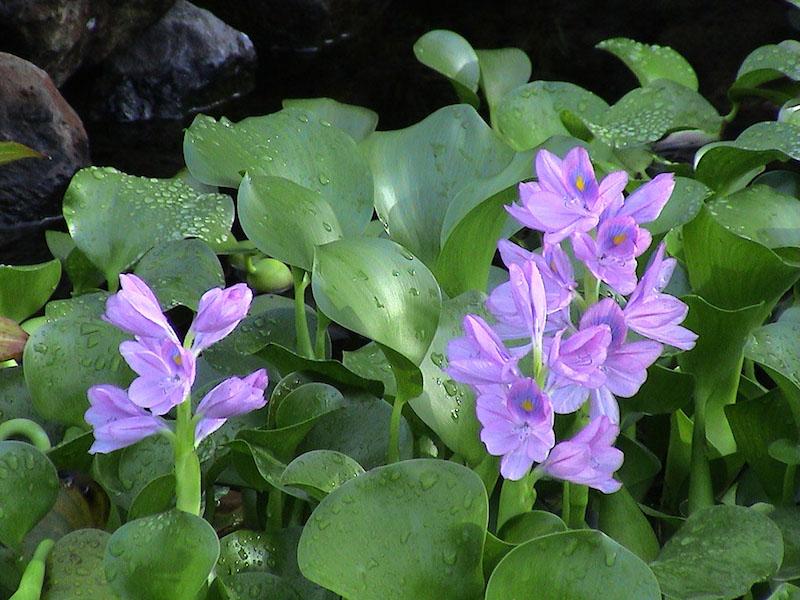
Two alien fish species have also been found in the lake, namely the Grass Carp (Ctenopharyngodon idella) and the Rohu (Labeo rohita), which are now being blamed as a factor in the decline in the numbers of the Inle Carp (Cyprinus Intha), one of the main food staples for the local people.
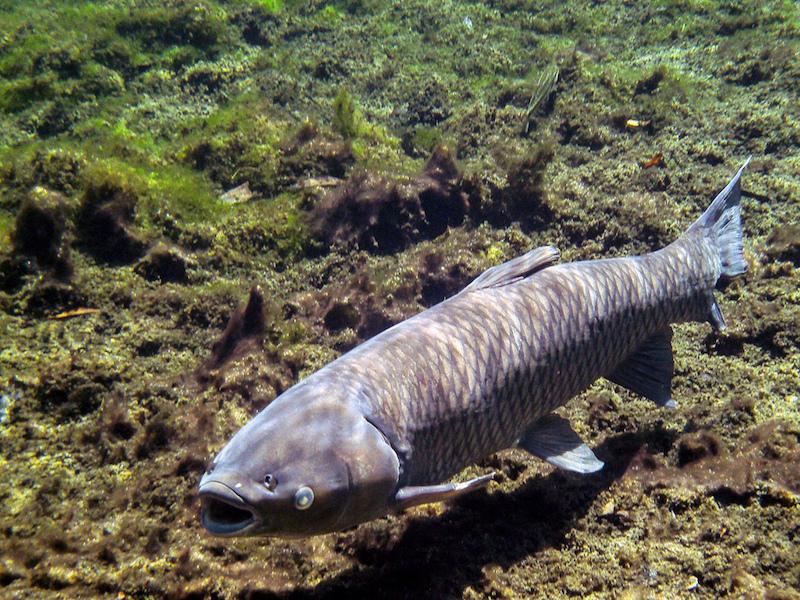
The layout
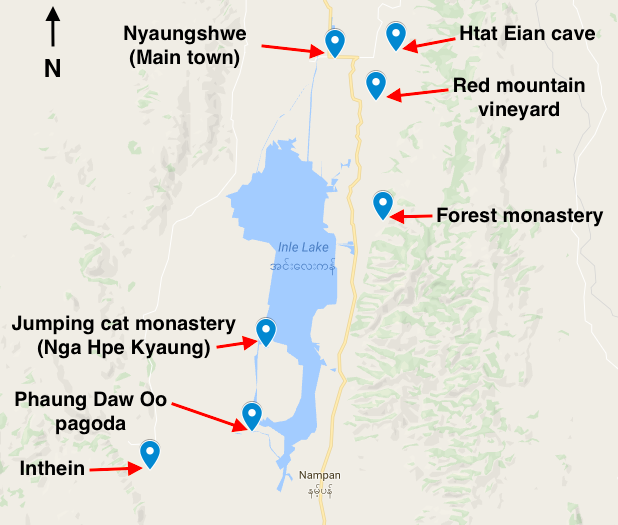
The grid-planned town of Nyaung Shwe is located a few kilometres north of the lake and is where most of the accommodation, restaurants and other facilities for travellers are found. A long canal links to the town to the lake.
Several of the important monasteries, floating gardens, handicraft workshops and other interesting attractions lie on the lake itself and are only reachable by boat, hence the reason that Inle lake cannot really be fully experienced without taking a boat trip out onto the lake.
Some other interesting attractions are found along the east shore of the lake such as the red mountain estate vineyard, the forest monastery near Maing Thauk and indeed just a short distance east of the town you’ll find the Htat Eian cave temple.These are all reachable by road.
Where to stay
While there are various places to stay scattered around the lake, we recommend you stay in Nyaung Shwe because of the great range of choices here in accommodation. You'll also have better access here to restaurants, local markets, bicycle rental shops and other facilities.
The standard of accommodation in Nyaung Shwe is surprisingly high, especially if you’ve travelled throughout the rest of Myanmar. The entire town feels like it was built just to cater to tourists, with fancy hotels, resorts and other accommodation of unusually high standards for the country.
The issue then won’t be finding quality, but finding a place that's not overpriced. Even though there are dozens of options here, tourists are also plentiful so prices can still be quite high, especially given that accommodation is already more expensive in Myanmar than in most other Southeast Asian countries.
We rejected several possibilities before finally striking a good bargain in The Green Valley Inn. The standard was quite high and we paid $5 per person per night here, which was only marginally more than our Myanmar average of $4 pp per night.
If you're planning to visit Nyaungshwe during the high season, you should definitely book in advance online as rooms can sell out fast and prices can get sky high.
Where to eat
Since Nyaung Shwe is a tourist haven, there is no dearth of overpriced tourist-oriented restaurants here and if you’re looking to splurge, you’ll have no problem finding a place to do so. The restaurants are often a blend of Chinese, Japanese, Western and Burmese Cuisine with some Indian restaurants floating around too.
Finding cheap, authentic local Burmese food is slightly more challenging. but if you’re on a tight budget don’t worry because we did find a few local restaurants in Nyaungshwe without the inflated prices. In these places you can order a decent meal for 2,000 kyat or less. Just wander around a bit and observe where the locals are eating.
Mingalar Market, towards the north side of the town is a good bet for buying cheap fresh produce like fruits and vegetables.
A very popular local dish is htamin gyin, a kind of fermented rice kneaded with fish and/or potato and served with twice-fried tofu or hnapyan gyaw and you might want to sample the Inle Carp or nga hpein, which is a staple for the local people.
You should also try the delicious traditional Shan style tomato salad, which includes sliced tomatoes, peanuts and shallots tossed with a sesame seed dressing.
Getting around
During our visit, we were disappointed to learn that motorbikes aren’t available to tourists for rental in Nyaung Shwe, unless you’re part of an organized tour group. This silly rule is apparently due to government regulation.
Anyhow, you can still rent ordinary bicycles in the town, which will still allow you to visit most of the outlying attractions, albeit more slowly. There are a few bicycle rental shops in Nyaung Shwe so there’s at least some competition to keep the prices reasonable at 1,000 - 1,500 kyat.
What to do at Inle Lake
The de rigueur thing to do at Inle Lake is to hire a boatman for a day or two to take you around to see the main points of interest in the lake. It’s the only way to truly experience Inle Lake, since so much of the action is happening out there on the water.
After that, there are several other interesting attractions found along the eastern shore of the lake such as the red mountain estate vineyard, the forest monastery near Maing Thauk and indeed just east of the town you’ll find the Htat Eian cave temple.Nyaungshwe itself also has several interesting pagodas and monasteries that are well worth checking out.
1. Enjoy a boat trip on Inle Lake
If you spend any time outside the confines of your guesthouse in Nyaung Shwe, you may not even have go searching for a boatman to take you out on the lake; it’s very likely that one will find you first.
However, if nobody approaches you, you can ask for a boat driver in local restaurants or head down to the main boat station early in the morning and talk to one the drivers directly. Travel agencies, hotels and other middlemen can also arrange a trip for you and this is certainly convenient but they'll tack on their commission, making it more expensive.
We befriended a boat driver at a local restaurant and he agreed to take us for 25,000kyat ($18), which included a visit to the far away Inthein village, which is famous for its 1,000+ crumbling brick and stucco stupas.
25,000 kyat is about the standard price for a boat but rates can drop much lower than this during low periods. Rates are also lower if you omit Inthein and other far away sights and just tour the core area of the lake. Sharing a boat between five people will be the cheapest way to do the trip but it can sometimes be difficult to get in with a group if you're travelling alone or as a couple.
The boat journey begins in the heart of Nyaung Shwe on the main canal that links the town to the lake. The canal is a roughly 5km long linear stretch of water that within the town is criss-crossed by wooden bridges and lined with stilt houses. Closer to the lake, the stilt houses disappear and are replaced by grassy marshland on either side, until finally you reach the open water of the lake proper.

The wooden tourist boats are fairly long and drivers will usually take up to 5 passengers. You get a padded wooden seat and life jackets. Drivers usually also carry umbrellas in case it rains or if you want one to create some shade.
The boats are fitted with single-cylinder inboard diesel engines and the driver operates them from the stern. They motor along at impressive speeds, the major drawback to this convenience being of the course the noise pollution and disturbance to the tranquility of the lake.

The itinerary of each boat trip will vary depending on the driver’s affiliates (they make a commission if you purchase tourist souvenirs), your plans, weather conditions and other factors so we will just describe our trip to give you a general idea of what to expect.
Our boat trip consisted of 6 main events: A visit to a random monastery, seeing the Kayan Lahwi women, exploring the stupas of Inthein, visiting a silvermsith workshop, watching the barge procession and finally, a visit to the jumping cat monastery.
Part 1 - Visiting a random monastery
Every year, an 18-day long event of major importance called the Hpaung Daw U festival takes place on the lake around the beginning of October and lo and behold, we had arrived at Inle lake just in time for Day 1 of this festival (entirely by fluke), meaning that our boat trip was going to be spectacularly eventful.
After about 20 minutes on the water, we eventually exited the open lake into a backwater system of canals and narrow water channels, eventually arriving at a T-junction to see the procession of boats floating by in the adjoining canal. We had apparently joined the tail end of the procession.
The canal was chock-a-block with wooden boats full of Burmese men, women and children, with everybody seemingly headed to a nearby monastery, which no map seems to know the name of.

This canal also had great examples of the stilt homes that the local people have built on the lake to allow themselves to live here. The stilts provide enough clearance to deal with rising water levels during the wet season.
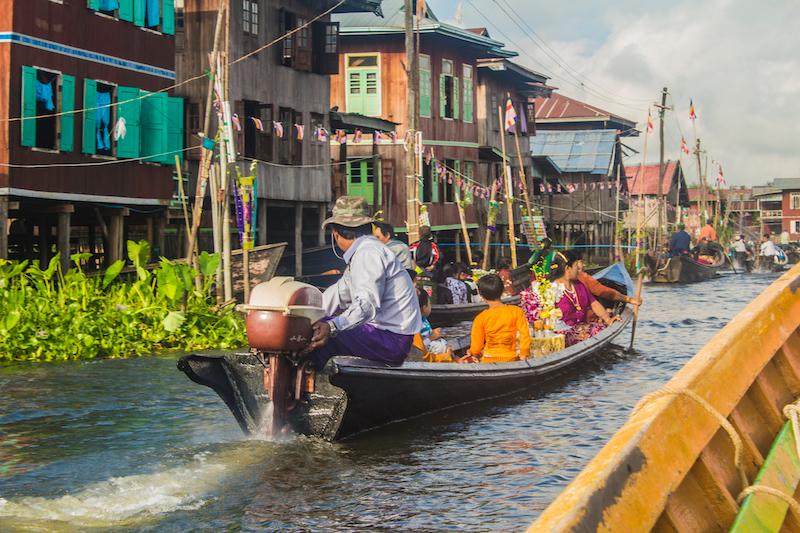
Navigating our way through the maze of boats, the canal became even more congested with boats as we approached the monastery:

We navigated through the maze of boats and moored the boat at a jetty area on one side of the monastery. The driver left us to explore the monastery for 25 minutes or so and we arranged to meet back at the boat.
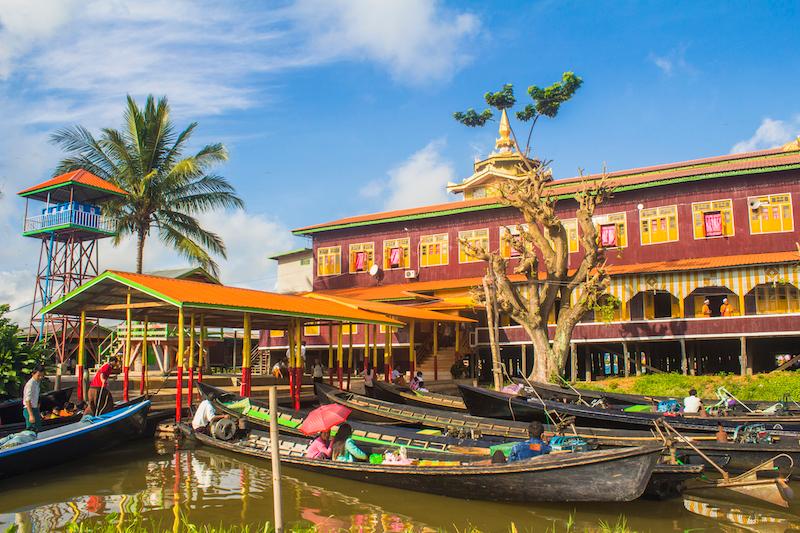
Inside the monastery there was a lively scene unfolding, with a great number of people eating and socializing on the ground floor in a large hall. Upstairs inside the main prayer hall, monks were seated having tea and dozens of people were knelt on the floor worshipping the main shrine.
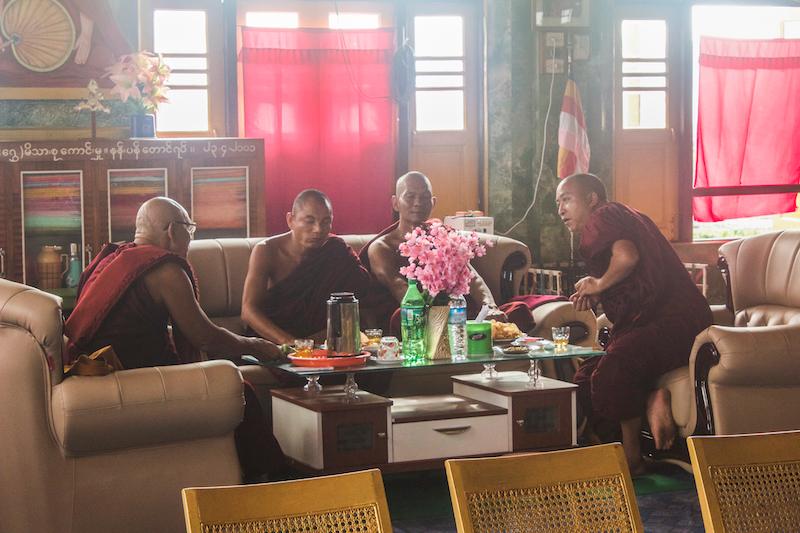
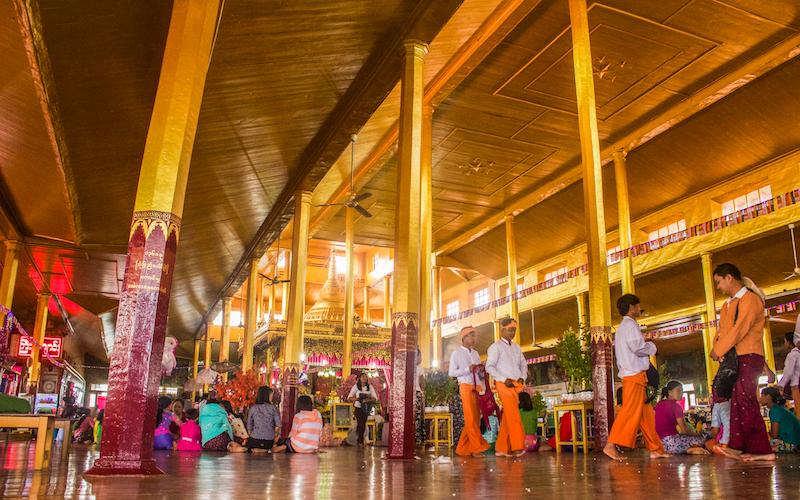
We were drawn towards the windows, which were decorated with beautiful pink curtains:
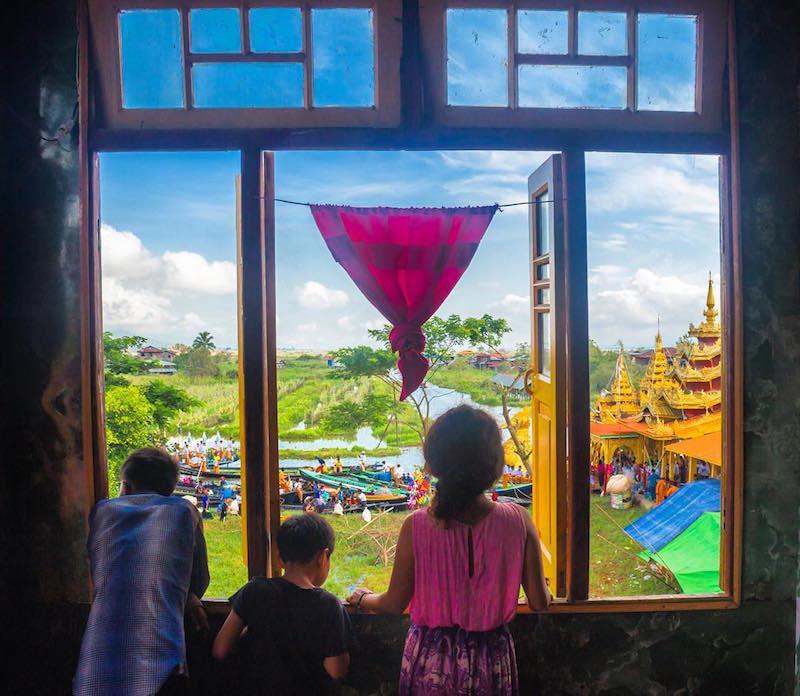
Gazing out the window we could see that the gilded barge that carries the Buddha images had been temporarily moored outside the pagoda.
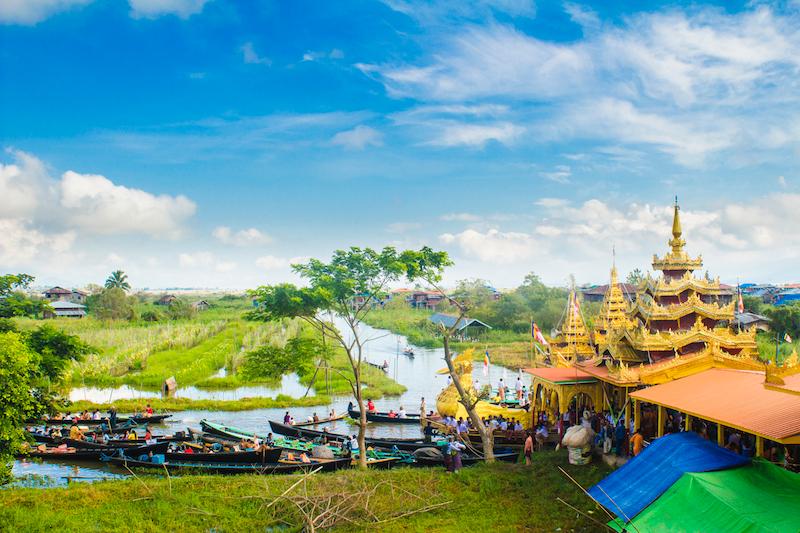
Where would the procession go next? We didn’t know but after soaking up the festive atmosphere here at the monastery for about 25 minutes or so, we decided to head back to our boat and proceed to our next port of call; a visit to see the highly unique, long-necked Kayan Lahwi women.
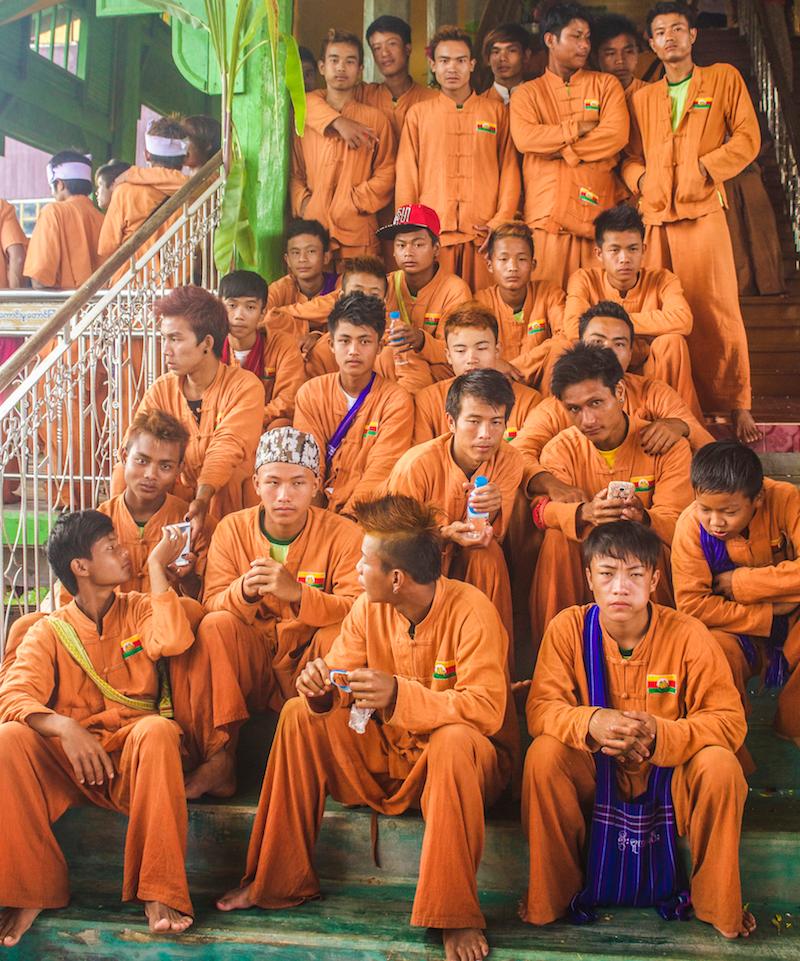
As we made our way back down the steps leading up to the monastery, we passed a group of Burmese boys dressed in the traditional orange attire that the Intha fishermen wear.
These boys play a central role in the procession, accompanying and towing the gilded barge in long wooden boats, which each has a team of up to one hundred identically dressed men rowing the boat, all using the one-leg technique.
A few of these long boats were moored at one of jetties attached to the pagoda, but it wasn't until later on that day that we were able to capture some amazing images of the procession in action, with the gilded barge being pulled along by the one-leg rowers.

The longboats are elaborately decorated with parasols, bunting and other decorations but just wait until you see them swiftly gliding through the water when fully manned by 100 men all rowing in unison with one leg! We'll show you that shortly.
Part 2 - Seeing the Kayan Lahwi women
After the monastery, the boat driver took us to a rather humble looking wooden building suspended over the water on long stilts. Just opposite this building we witnessed a spectacular display of stupas, most of them fitted with golden spires that gleamed in the bright midday sun.

This waterfront monastery complex is known as the Aung Mingalar Pagoda and it lies just east of Ywama village. After admiring the stupas for a few minutes, we stepped inside the shaded building, away from the scorching heat of the sun.
We were immediately greeted by two of the long-necked Kayan Lahwi women, who were pleased to pose for several photographs for us. The implicit deal here is that the women pose for the camera and you maybe buy a few souvenirs from the adjacent shop in return.
.jpg)
These women belong to a small group known as the Kayan Lahwi and refer to themselves in their own language as Kakaung, which means 'people who live on the hilltops'. The Shan people refer to them as the Padaung, although this term may have slightly derogatory connotations.
The Kayan Lahwi are a subgroup of the Kayan, which has five or six other subgroups in Burma. But wait, it gets more complicated; the Kayan are themselves a subgroup of the Red Karen or Karenni people.
The Kayan people are not actually native to the Inle lake region. Their original homelands are the mountainous areas of Kayah state of east-central Burma, where Burma meets Mae Hong Son Province of northwestern Thailand and the southern reaches of Shan state.
They're said to number about 20,000 in Kayah state and 40,000 in Shan state. A small number are also now living Thailand, having fled there as refugees in the late 1980s and early 1990s to escape the fighting between the Red Karen and the Burmese military.
Some Kayan Lahwi women have set up workshops here on Inle lake because of its economic potential for them, attracting in tourists with the bizarre looking neck coils.
However, the tradition of wearing the neck coils is actually fading in Myanmar, partly due to discouragement from the Burmese Government. Reportedly only three remote villages still practice the tradition. The women here are really only wearing the neck coils because it’s financially lucrative for them to do so.
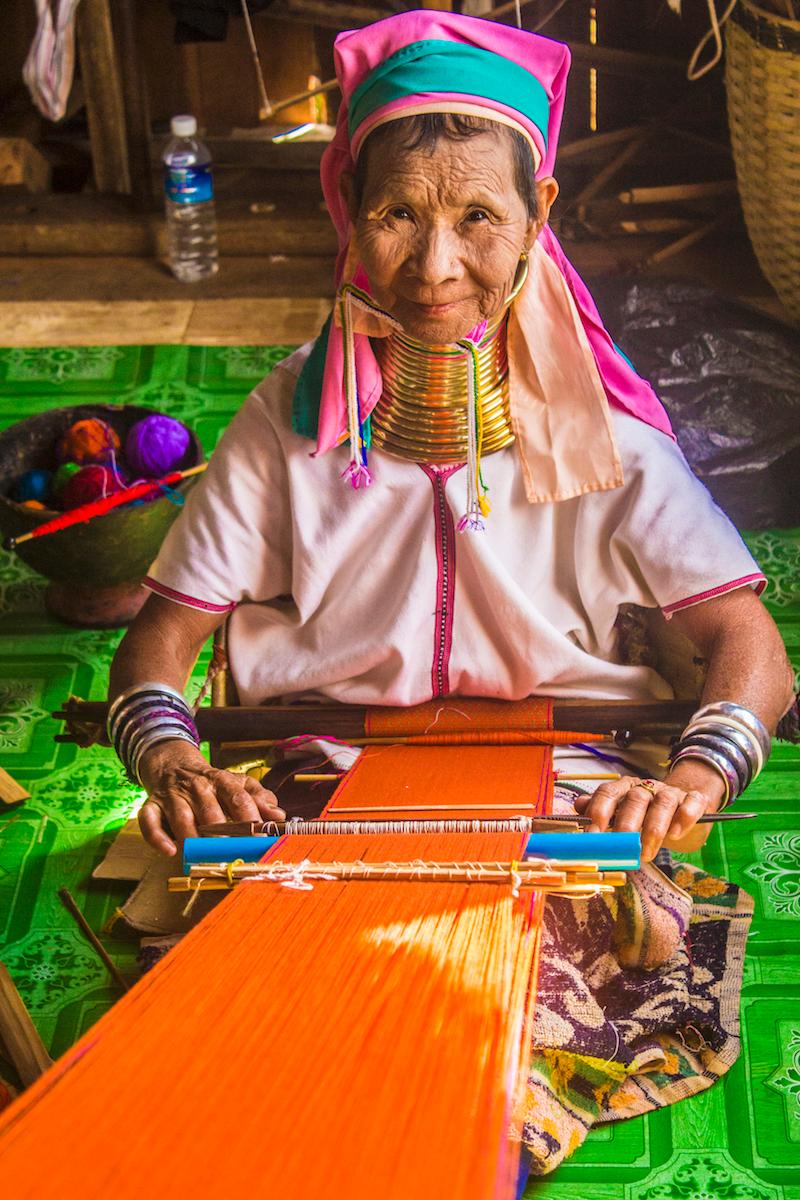
Understandably, tourists are rather fascinated by the women’s apparently elongated necks, which can be fitted with as many as 32 brass coils, formed of one long, continuous spiralling piece.
The brass coils don’t actually cause the neck to elongate, but their weight does push down against and deform the collarbone and ribcage, giving the illusion of elongation.
The unusual looking necks have earned the Kayan Lahwi some derogatory terms like the French term ‘les femmes giraffes’ (the giraffe women) and also the terms ‘long necks’ and ‘long neck Karens’.
Girls traditionally first start wearing the coils at the tender age of 5, adding one extra coil each year until marriage. Replacing the coils is supposedly a lengthy and difficult procedure. They also sometimes have to be removed for medical examinations.
After several years of wearing the coils you can understand how they would begin to feel like an integral part of the woman’s body. Women who renounce the coils altogether have weakened neck muscles and report some physical discomfort for a few days afterwards. The neck area can also remain discoloured for a long time.
But the burning question you may be wondering is why? What is the purpose of this bizarre tradition? It’s not such an easy question to answer definitively but there are plenty of theories in circulation.
One explanation is that the coils were used to make the women less attractive to neighbouring tribes, protecting the women from being kidnapped and becoming slaves. Another idea that’s totally conflicted with this one is that the coils make the women more beautiful by exaggerating the natural slenderness of a woman’s neck and making her appear more feminine.
Another popular theory claims that the coils protect the women from tiger bites, which usually occur in the neck region or another suggestion is that the coils make the women resemble a dragon, which is an important element in Kayan folklore. The original reasons for the tradition have perhaps been forgotten.
The Kayan Lahwi are also known for their weaving of colourful fabrics, performed on a backstrap loom, which is one of the most primitive types of weaving devices.

In this technique the lengthwise threads (warp threads) are attached to a fixed object at one end and to a belt around the woman’s waist at the other. In this manner, she can keep tension on the warp threads and keep her hands free to weave with the weft threads.
After thanking the women for the opportunity to photograph them, we headed out the back door of this building and discovered a cover walkway leading off to the left, lined with endless souvenir stalls. This was apparently some kind of big tourist market.
Our boat driver however would not make any commission that day, as we had no intentions of purchasing any souvenirs. Our backpacks were already full to the brim with travel necessities. We decided to investigate the market anyway just out of curiosity and see what was on display.
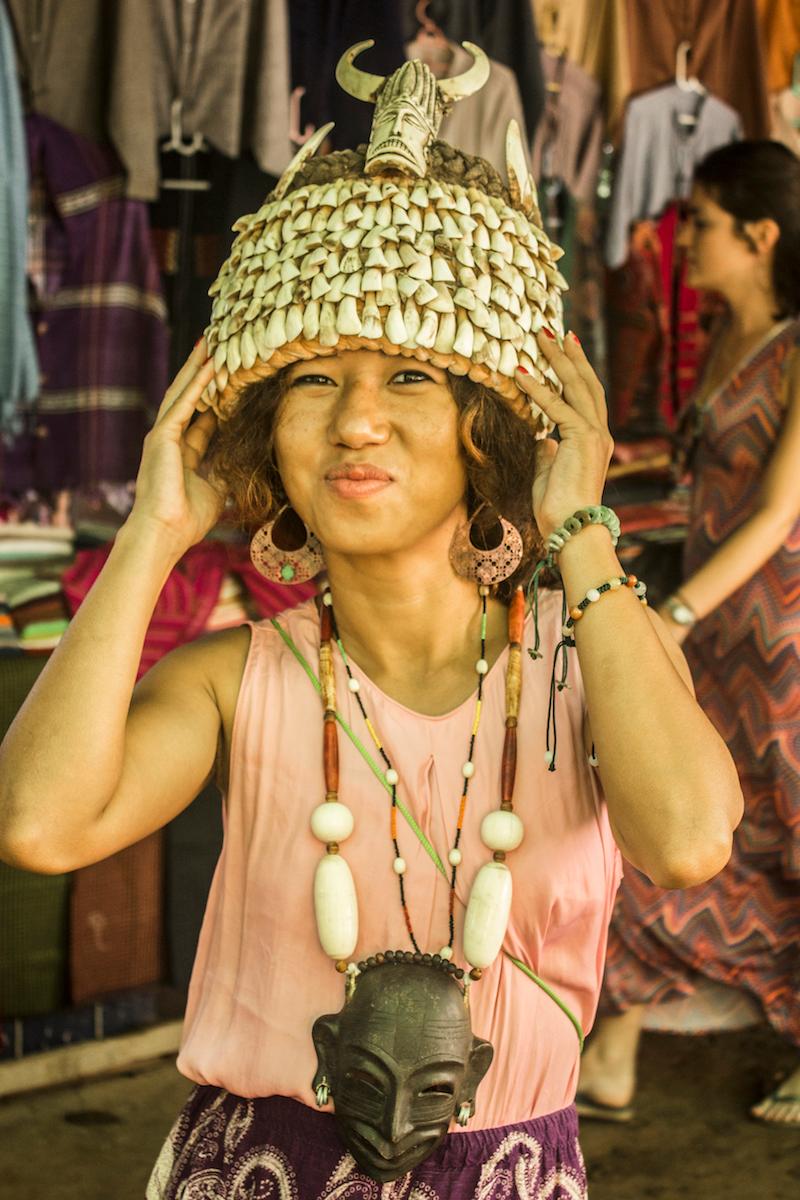
There were semi-precious stones, mirrors, ornately carved pipes, buffalo horn cutlery, weighing scales, clothing, shoulder bags, woodcarvings of all sorts, boxes, ornaments, bracelets, silver jewellery… you name it, they had it.
The most intriguing find though were the tribal headdresses, which were decorated with hundreds of what looked to be human teeth.
Back in the workshop there were several more tribal headdresses on display, many of them again sporting human teeth but also animal skulls, buffalo horns, porcupine quills, clam shells, pig tusks and other curiosities.
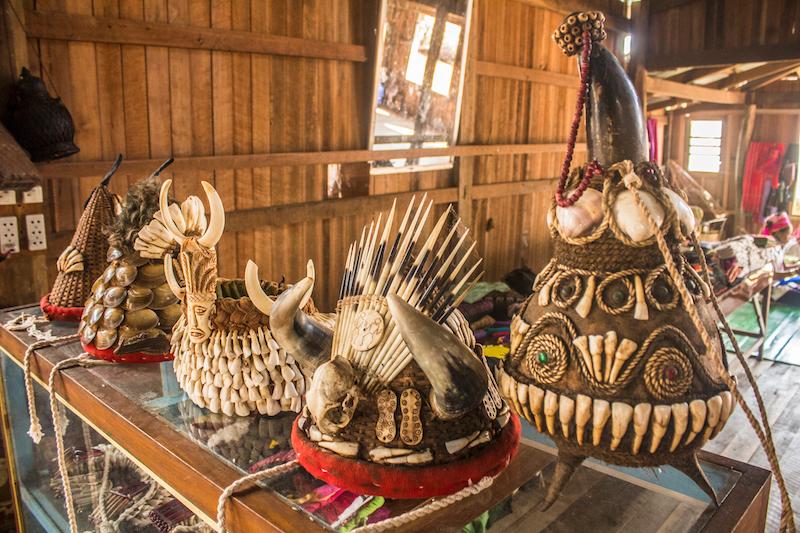
After this visit had run its course, it was onwards in the boat to the village of Inthein, which turned out to be the highlight of the entire trip.
Part 3 - Visiting Inthein

The boat journey from the monastery to Inthein took about 20-25 minutes, winding for the most part along a scenic narrow canal lined with trees and other vegetation. We moored the boat at the jetty in Inthein and arranged to meet our driver again in 2 hours or so.
Inthein could hardly even be called a village; it’s really just a collection of small homes, shops, a few restaurants, a school and a few monasteries. It is however one of the five villages that host the five-day rotating market and apparantly Inthein is one of its most lively stops.
There are two main groups of weather-beaten stupas found just to the south and southwest of Inthein village, with a third smaller group found just 400 metres or so west of the main boat jetty area.
The largest and most impressive group, known as Shwe Inn Thein Paya, is perched on a small hilltop southwest of the village and is reached by a long covered walkway lined with endless souvenir stalls. It features 1,054 stupas, of which some are modern, some have been partially or fully restored and others are still as time left them.
The stupas are mostly dated to the 17th and 18th centuries, with the earliest stupa carrying an inscription dating it to the 14th century.
There are few historical records available regarding who built the stupas but it's most likely they were commissioned during the reign of King Narapathisithu and later renewed by King Anawrahta, who were both kings of the Bagan empire.
However, legend holds that the stupas were built by the great Indian emperor Ashoka in the 3rd century BC, to commemorate his visit to the lake, although there's no evidence supporting this theory.
We first stumbled across the smaller group of stupas near the jetty and were rather impressed. The brick stupas were originally covered in stucco (plaster) but much it has worn off over time exposing the brickwork underneath.

All of the the stupas here are built in a very unique architectural style that you won’t see anywhere else in the country.
The metal crowns or hti are very long and terminate in a needlelike point. Some of them lean at extreme angles and many are missing from the stupas altogether.
You’ll also notice that many plants, shrubs and trees have gained a foothold in the cracks of the brickwork of the stupas, which greatly adds to their beauty but also accelerates the process of decay.
There are a few more stupas up on a hilltop near here and supposedly fine views of the lake but we didn’t climb this hill, choosing instead to press on and see the first of the two main sites, known as Nyaung Ohak, where there’s another fine cluster of ruins.

The Nyaung Ohak site, which translates to 'group of banyan trees', is found just south of the village on a small hill. You have to cross a bridge over a small river to reach it.
As with the previous group, the process of reclamation by nature is well underway here but you can still find some ornate stucco carvings of animals, devas (celestial beings) and chinthes, which are the lion-like creatures that are found in pairs, guarding the entrances to pagodas all throughout Myanmar.

Unfortunately, it was difficult to photograph and explore this group of ruins in peace because a group of tribal women had latched onto us and were pestering us incessantly to buy their woven blankets, which we had little use for in the scorching hot weather.
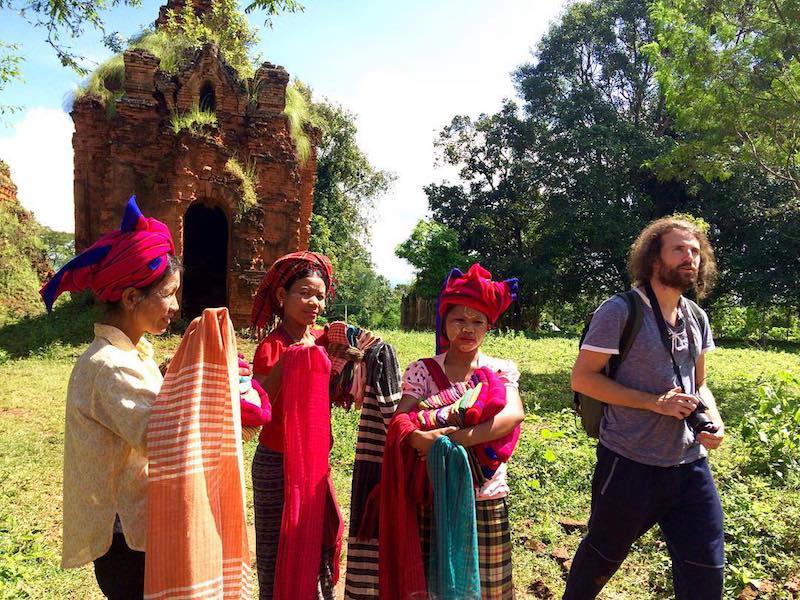
In addition to the dilapidated stupas, we found a very impressive looking temple building with three archways on its front face.

Two ornately carved devas guarded the central archway and inside we discovered a unique looking Buddha statue at the end of a narrow passageway, seated within a small chamber in the subduing mara mudra (earth-touching gesture).

Taking a closer look at the Buddha image within, we could see that it was buried in soil and rubble almost up to shoulder level. There was an opening above the image, which light was pouring in through. Had the original roof covering the Buddha image collapsed in on itself?

Crouching inside the narrow passageway, we were able to take a closer look at the fascinating Buddha image within.
We could see that it was buried in soil and rubble almost up to shoulder level and there was an opening above the image, from which light and weeds were infiltrating the chamber.
Had the original roof covering the Buddha image collapsed in on itself?
After we had had our fill of this site, it was time to explore Shwe Inn Thein Paya - the main site on the hilltop southwest of the village with 1024 stupas. We approached the site from a side road, allowing us to avoid the long covered walkway selling souvenirs to tourists (i.e sales funnel).
The main site is definitely the most impressive of the lot and presents some incredible photo opportunities.There are stupas on both sides of the covered walkway but we mainly explored the larger area on the south side.
The older brick and stucco stupas are found lower down and as you progress further up the hill you eventually find yourself among modern stupas and a beautiful temple compound.
We encountered an interesting elderly woman among the stupas. She was sat down with her bundle of firewood smoking a cigar:

We spent the next thirty minutes or so just wandering around the old weather-beaten stupas in fascination and taking lots of photographs.
We found several more ornatecarvings throughout our wanderings. Some of the stupas still house their original Buddha images so don’t be afraid to peer inside a few. Sometimes all you'll find is cobwebs but surprises always await the curious traveller.
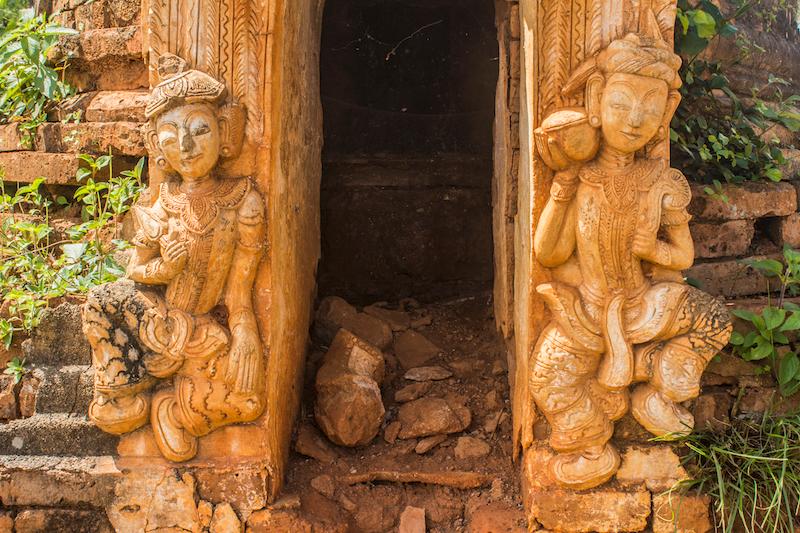
We don’t have a whole lot more to say about this experience so we’ll just let the photos do the talking:





At the top of hill beyond all the crumbling stupas, there's a collection of modern stupas, painted mainly in white and orange colours. They aren't as impressive as the older ones surely, but are visually pleasing nonetheless:
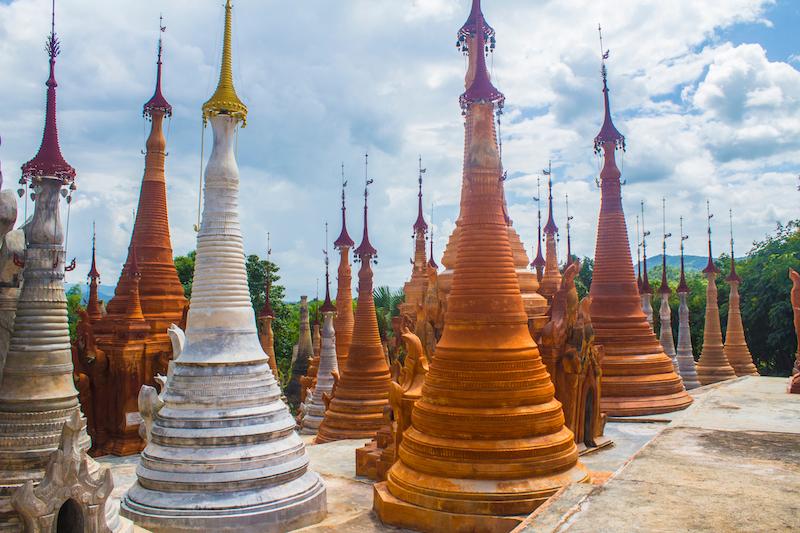
The visual delights only continue in the modern temple, which is found just adjacent to the cluster of orange and white modern stupas and right at the end of the long covered walkway:
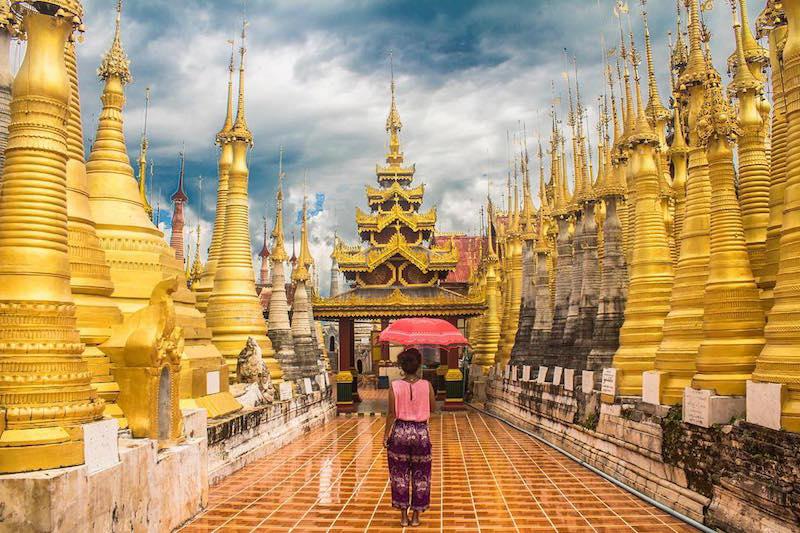
I don’t think we’ve ever seen quite so many glimmering golden stupas, so densely packed together, anywhere else in Southeast Asia. This is an incredible place.
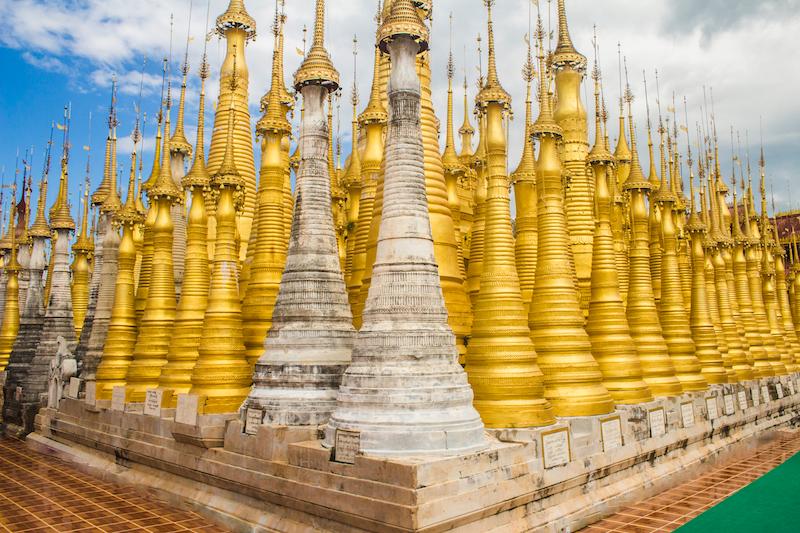
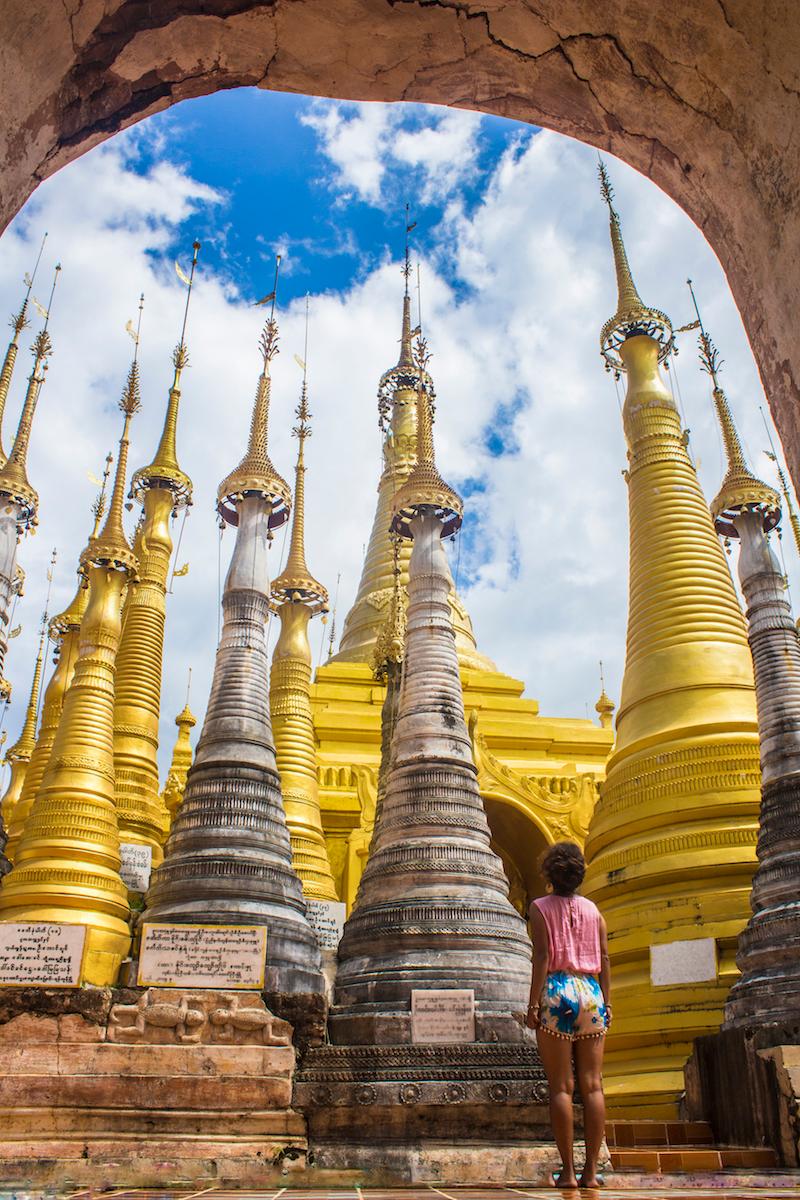
At the centre of all this is the shrine of the Inn Thein Buddha image, which some would claim was built by King Ashoka over 2,000 years ago.
The Buddha image within the shrine sits in the meditation mudra or gesture but we didn't enter inside to see it, having already seen enough Buddha images that day.
We eventually grew tired of all the glitter and glamour and decided to make our way back to the boat via the long covered walkway, curious to see what they were selling.
We passed by dozens of stalls selling shoulder bags, longyis, shirts jewellery, pipes, ornaments etc. What really caught our eye were the wood carvings of the long-necked Kayan Lahwi women, which were perhaps a little exaggerated, but beautifully made nonetheless.
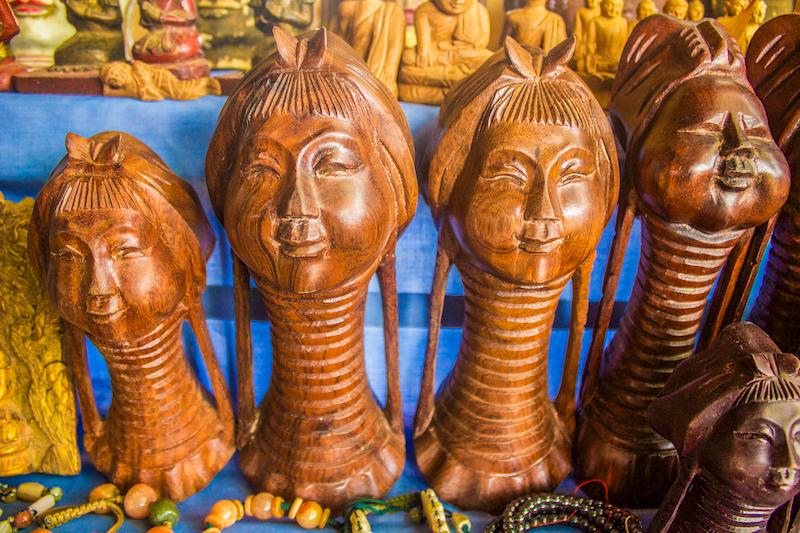
Upon returning to the jetty area, we eventually found our driver inside a nearby restaurant and we hopped in the boat and sped back to the main part of the lake along the same winding canal that brought us here.
Our next port of call would be a silversmith workshop, located quite near to the Kayan Lahwi workshop that we visited earlier that day.
Part 4: The silversmith workshop
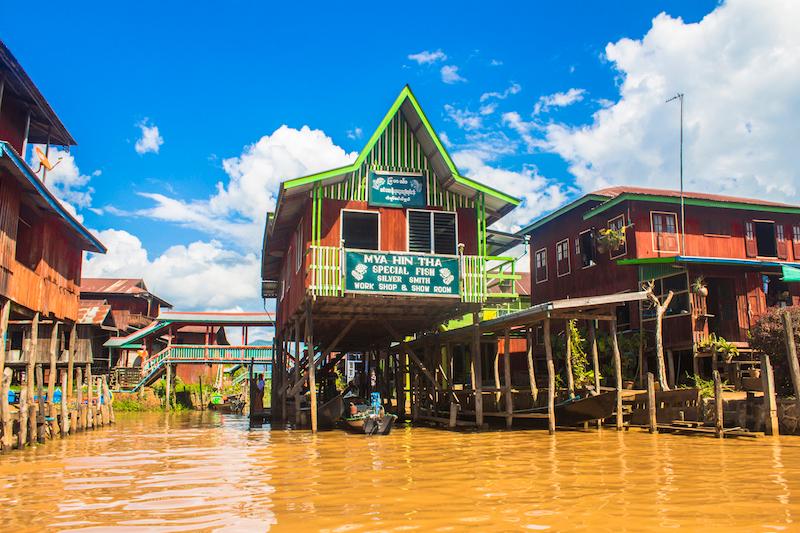
There are several silversmith workshops dotted around Inle Lake but the one we visited is called the Mya Hin Tha workshop.
The wooden structure housing the workshop is raised high above the water on stilts. Inside the workshop, you can watch the process of working the silver and there’s also an attached showroom where they attempt to sell finished silver jewellery pieces to tourists in nice display cabinets.
Inside the workshop, they had an interesting hand-operated bellows for blowing air into the forge and a man was at work creating little silver ingots.
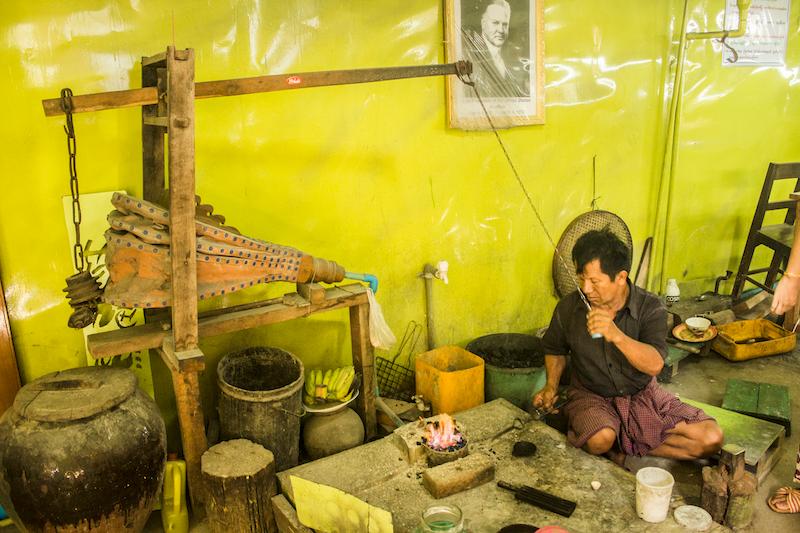
The owner’s granddaughter talked us through the silversmithing process and showed us an interesting piece of ore that the silver is extracted from.
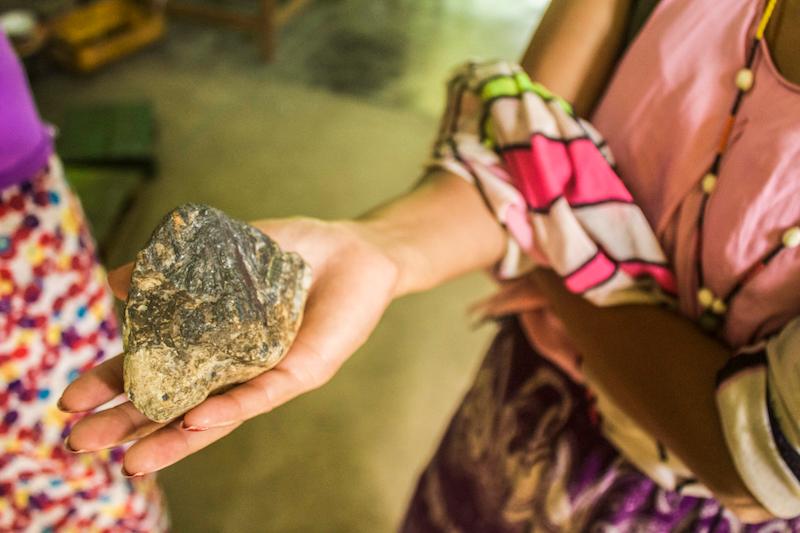
The girl also showed us the special silver fish ornaments that the workshop is famous for producing. These ornaments are handmade from overlapping pieces of silver, such that the male ornament can only bend from side-to-side and the female ornament can only bend in the vertical plane, as if jumping.
It’s a fascinating design and we couldn’t figure out how it worked. You can see the silver fish ornaments in our video at the end of the article.
The family here has supposedly been working with silver for over three generations and the work is of excellent quality. In the showroom you’ll find silver necklaces, bangles, brooches, chains, rings etc of top quality for reasonable prices.
Part 5: Watching the procession
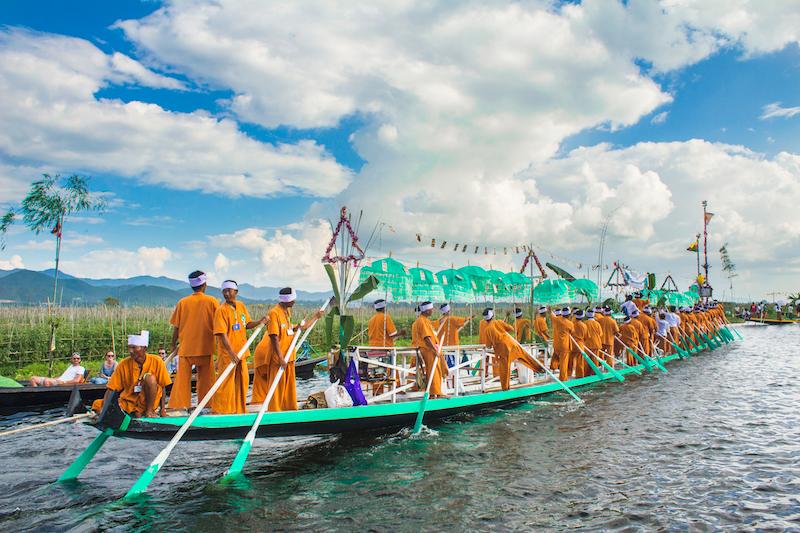
After we’d had our fill of the silversmith factory, the boat driver dropped us off at a nice restaurant just nearby for a spot of lunch. There are a few decent restaurants along this stretch but they’re a little overpriced because of all the tourists they receive.
After eating a nice meal, we hopped back in the boat and the driver took us north along a different canal. After travelling along the canal for a few minutes, we pulled up against the reeds lining the canal and patiently waited. The plan was to intercept the procession, which was very shortly going to come down this canal and pass right by us. Other boats filled with tourists were waiting here too.
Eventually, the first boats arrived and we were treated to one of the most spectacular sights we’ve ever witnessed before. Dozens of long boats charged along the canal at impressive speeds, each powered by as many as one hundred Burmese men, all rowing in unison with one leg.
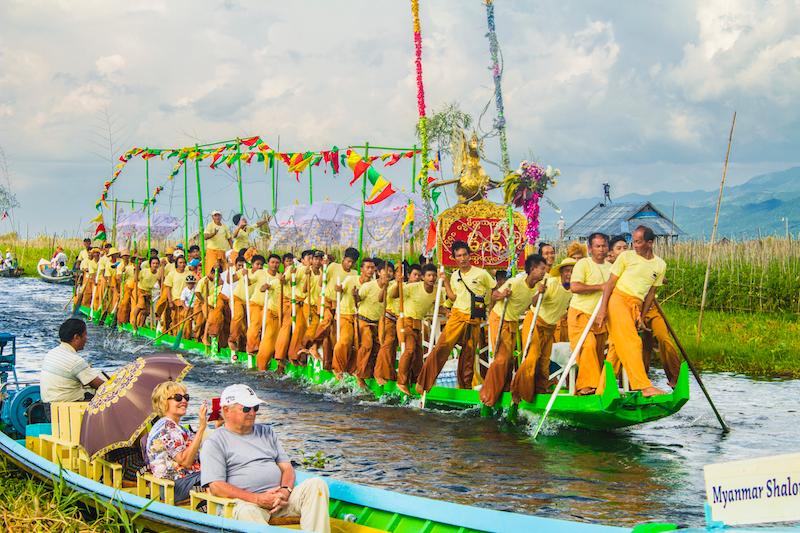
The boats were painted with varying colours and decorations and there were also several different outfits worn by the rowers, with one particular outfit for each boat.

After many of the leading boats had passed, we saw that the gilded barge was approaching, towed by the leg power of the hundreds of men before it.

There was another smaller barge out in front of this main barge, coupled to it by ropes and also fashioned in the form of a hintha bird.
The two golden barges were gleaming brilliantly in the afternoon sunlight and a beautifully dressed monk stood at the front of the main barge, accompanied by several other finely dressed men. It was an amazing sight to behold.
Scores of tightly packed, small wooden rowing boats tailed behind the golden barge, each boat occupied by as many Burmese people as they could hold. The tail of wooden boats extended for several hundred metres or so until eventually the procession had passed and the canal was clear once again.
We started up the engine once more and continued heading North along the canal, making for our last and final destination - Nga Hpe Kyaung, also known as the jumping cat monastery.
Part 6 - Paying a visit to Nga Hpe Kyaung (jumping cat monastery)
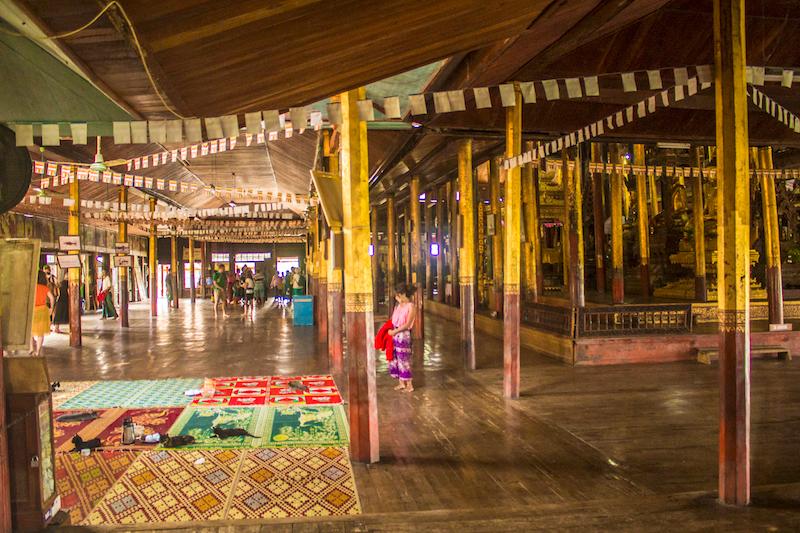
Nga Hpe Kyaung is a wooden monastery built on stilts over the water and it’s over 200 years old. It’s not as glamorous looking from the outside as some of the other monasteries on the lake but this monastery holds all of its treasures within its walls.
The monastery got its nickname ‘jumping cat monastery’ because formerly, a monk had trained domestic cats living at the monastery to leap through small hoops for tourists, by rewarding them with a piece of fish or meat every time they performed the trick successfully.
However, the monk who trained the cats eventually passed away and with his death, the practice also ceased. Nowadays, the new generation of cats lazily sleep or lounge about on a rug all day long in the dimly lit meditation hall of the monastery.

The main reason to visit nowadays is to see the amazing and diverse collection of beautiful Buddha statues in the Shan, Tibetan, Bagan and Inwa styles. The main meditation halls features over 20 different Buddha images encased within shrines or seated atop ornate wooden and mosaic pedestals.


Many of the original Shan Buddha images that were kept inside the cases here inside the meditation hall have actually been sold or stolen.
A lot of the images you see nowadays are therefore modern replacements for these originals.
You’ll surely soon tire of the slumbering cats, book-reading monks and Buddha images, so if you want to take a breather, we suggest you head out the back door of the monastery, where you’ll find an open-walled corridor and boat landing area with superb views of the lake and the mountains beyond.

When we left the jumping cat monastery in the boat, we were pretty satisfied with the way our day had gone and we instructed our boat driver to bring us back to Nyaungshwe. During the journey back, the clouds had become dark in colour and suddenly we found ourselves getting pelted with the most torrential rain imaginable as we sped across the open lake towards Nyaungshwe.
Luckily the driver had brought several umbrellas and we were able to protect ourselves from the worst of the rain by holding the umbrella in front of us like a shield. The rain was literally coming in horizontally from directly in front, so it made way more sense to hold the umbrella sideways.
We eventually got back to Nyaungshwe pretty drenched and freezing cold so we walked back to our guesthouse from the boat landing area and had a hot shower to warm up. The driver later visited our guesthouse and we paid him and thanked him for the wonderful day.
Some tips for the Inle Lake boat trip:
- Bring an umbrella, sarong or other garment to offer sun protection. An umbrella is best because there’s also a chance that it might rain, as happened to us. Boat drivers usually provide umbrellas but you probably can’t rely on that.
- Thanakha powder is commonly found in Myanmar and local people wear it as a sunscreen. The cream-coloured powder comes in a small tub and is made from the ground bark of several native trees. All you have to do is wet a sprinkle of it to make a paste and apply it to your skin. We quickly realized it’s far superior to artificial sunscreen (way cheaper too) and offers excellent sun protection without the cancer causing agents.
- Traditional khamauk hats, made from bamboo can be bought at some of the markets on Inle Lake. These are a bit like the Vietnamese leaf hats and excellent for keeping the sun off your face and neck. Consider buying one for the boat trip.
- Bring plenty of water to stay hydrated because it’s a long day and much of the time you’ll be out in the scorching afternoon heat. Bring some snacks also because the restaurants on the lake can be pretty expensive.
- Bring a warm jumper if you're heading out on the lake very early in the morning because it can be quite chilly (around 13°) in the cool morning air in the fast moving boat. Mists often hang over the lake in the early morning, indicating how cool the air gets.
2. Explore Htat Eian cave temple
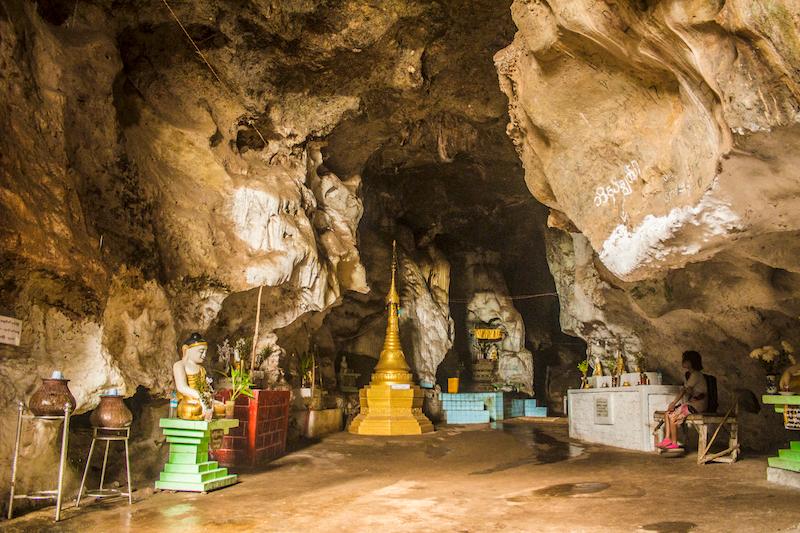
This is an interesting cave with many deep passageways and numerous Buddha images. A monk also lives here inside the cave and other monks come here to pray and meditate. It’s located about 2.9km east of Nyaung Shwe and is easily reached if you rent a bicycle in the town.
Getting there:
To get to the cave from Nyaung Shwe, first get onto Yone Gyi street and head east out of the town along this road. When the main road first curves left don’t follow it; instead keep going straight down the narrow road. This smaller road brings you up over a hill and everything soon becomes quite picturesque.

From the crest of the hill just continue straight down to the bottom of the hill and follow the road over a small bridge. Continue following the road as it curves left, ignoring the smaller road heading off to the entrance to a monastery with two chinthe (lion-like) statues.
The road ends at the foot of some steps and at the top of the steps you’ll find the entrance to the temple.
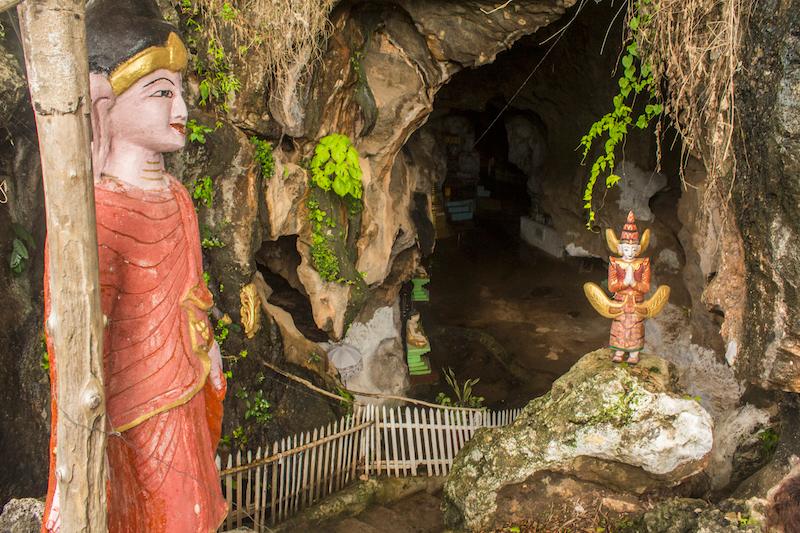

After descending down the steps and entering the cave, you’ll find yourself inside a large chamber decorated with Buddha images that are seated on pedestals.
It’s not so dark here near the entrance with all the light spilling in but this cave holds some interesting secrets if you're prepared to delve a little deeper.
Near the back of this main entrance chamber there are some steps leading down to the right into pitch darkness.
If you bring a headlamp like we did, you can explore this pathway, which leads you into a long network of narrow tunnels, which surprisingly enough are lined with small Buddha images perched on little shelves. Hiding in the darkness, we discovered lots of unique looking images like this one:
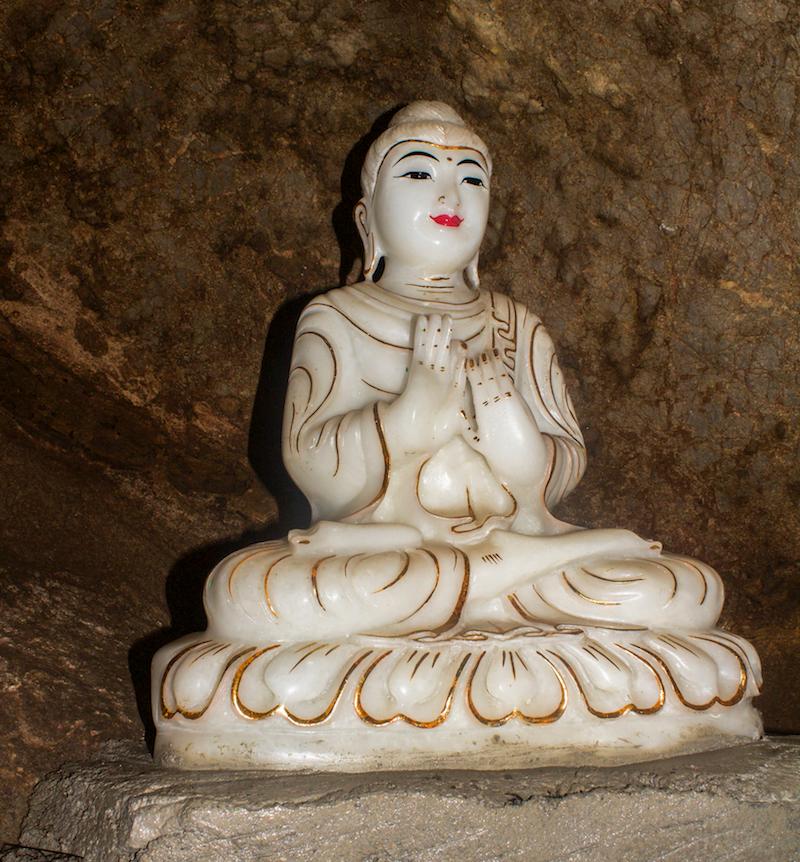
We soon decided to head back to the main chamber as we didn’t want to go too deep into this cave and we didn’t know how far back it extended. Back in the entrance chamber, there’s another large chamber immediately off to the right (if you’re facing the steps) and this chamber is chock-full of Buddha images.

To our amazement, some awareness-lacking tourists came in, took a few selfies and then left, completely missing the most interesting part of the cave. It was really dark inside this second chamber so we had to use our camera flash:
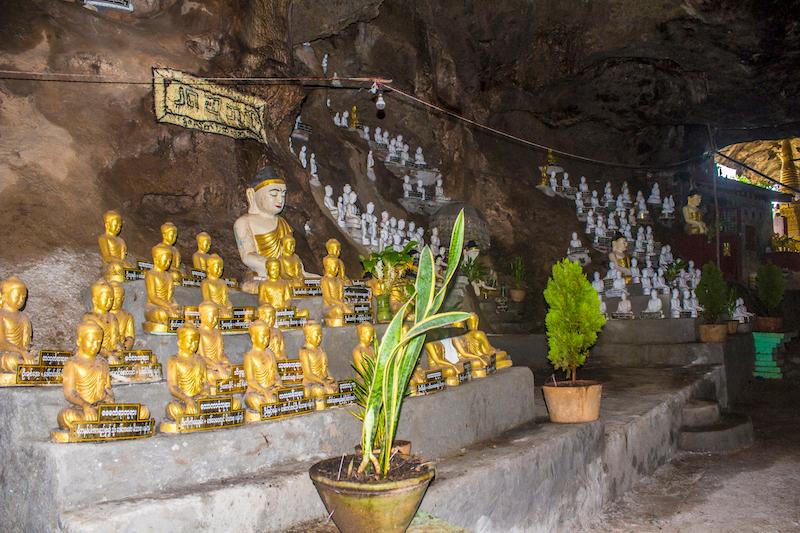

At the end of this second chamber on the right hand side there’s a very interesting tree rooted half-way up the wall of the cave, its branches extending out through an opening in the roof of the cave, where light is spilling through.
On the left hand side, you emerge from the darkness of the cave into the outside world again.
Out here there’s a small golden stupa, several more Buddha statues and you can even see a reclining Buddha image if you go down the steps and then turn right and walk along the edge of the building below.
While out here we were fortunate enough to meet the monk who lives here inside the cave temple. He had been ignoring all of the other tourists but had taken a shine to us for some reason.
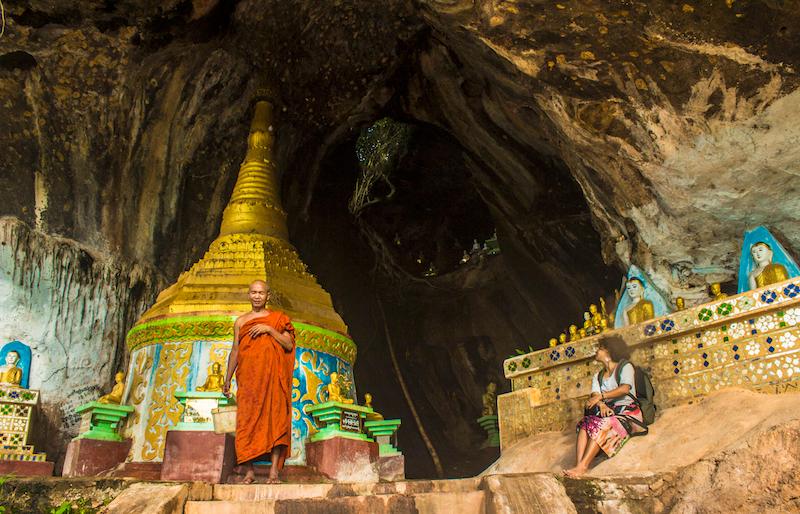
The monk wanted to show us his private room where he sleeps and while inside he gave us the opportunity to take a photograph of him. It was very dark in here so we again were forced to use the camera flash:

And that's basically Htat Eian cave temple folks. It's definitely worth a visit to mix things up and a good place to escape from the midday heat.
3. Try wine tasting at the red mountain estate vineyard & winery
.jpg)
It might be hard to believe but there’s an actual vineyard found here at Inle Lake but the climate here is suitable for growing grapes, although the average yield here for red grapes is much lower than in temperate climates. Visiting this place is a unique experience in Burma and will make you feel as if you’ve suddenly been transported to the Mediterranean.
The red mountain estate is located on a small hill just off the main road, about 4.5km southeast of Nyaung Shwe.
Getting there:
To get to the estate from Nyaungshwe, head to the southeastern corner of the town and get onto the main road that runs south for several kilometres alongside the lake. About 2km out the main road, you have to take a left turn and go up the hill until you reach the winery.
The estate is owned by French vintner and wine-maker Francois Reynal and the 400,000 plants growing in the vineyards are mostly imported from France and Spain. Some local Pa-O women are employed in the harvesting of the grapes from the vineyards.
The winery was set up in 2002, making it a bit younger than Aythaya, which was established in 1999 and claims to be the first vineyard estate in Myanmar. The first year of wine production was 2006 when 1,000 bottles of red and white wine were produced. Today the annual output is about 120,000 bottles.
There are many varieties of wine on offer at the estate. Red wines on offer include Tempranillo, Pinot Noir, Shiraz (or Syrah) and Carignan. White wines include Sauvignon Blanc, Chardonnay and Late Harvest. There are also rose wines, fortified wines like white muscat and red tawny and several experimental wines. Supposedly you can’t taste the wines here outside of Myanmar except for perhaps in China, because of the strict exporting regulations.
The winery (where the wine is produced) uses the latest modern technology in the wine production process. One room here contains rows of giant (10,000+ litres capacity) stainless steel fermenting vats and there’s also an underground wine cellar where the wine is stored inside Hungarian oak barrels. It may be possible for you to take a tour of the winery when you visit.
A restaurant opened here in 2011 and most tourists will sit here to chug down a few bottles of wine or have a meal. We didn’t try the food or the wine but we didn’t read any terribly negative reports about the quality of either. The food and the wines were a little pricey though.
There’s also a wine-tasting shed near the restaurant, which is basically an open-walled veranda with wonderful views of the surrounding vineyards. It was quite busy with tourists when we visited. Here they serve smaller quantities of wine but you still have to pay.

Even if you aren’t at all interested in wine, the estate is still worth visting for the commanding views of the lake and the surrounding hills. Many people arrive for sunset when the atmosphere is at its most magical. We arrived and departed just before sunset but the views from the restaurant were still superb:

4. Visit one of the forest monasteries
The most famous forest monastery at Inle Lake is the one on a hilltop near the village of Maing Thauk. This village is found further south along the same road that leads to the red mountain estate. We didn’t get a chance to visit this but it’s reportedly quite a long and steep walk up the dirt road to the hilltop, with fine sweeping views once you reach the monastery.
Since sunset was approaching fast, we instead visited a different forest monastery only a short distance south of the red mountain estate. We don’t know the name of this monastery but it was marked on one of our maps apps (maps.me) so we went to check it out.
We made a turn off the main road and eventually managed to navigate our way to the monastery through a maze of confusing lanes and backroads. The monastery was a very old and ramshackle wooden building built on stilts, located in a secluded forest clearing.
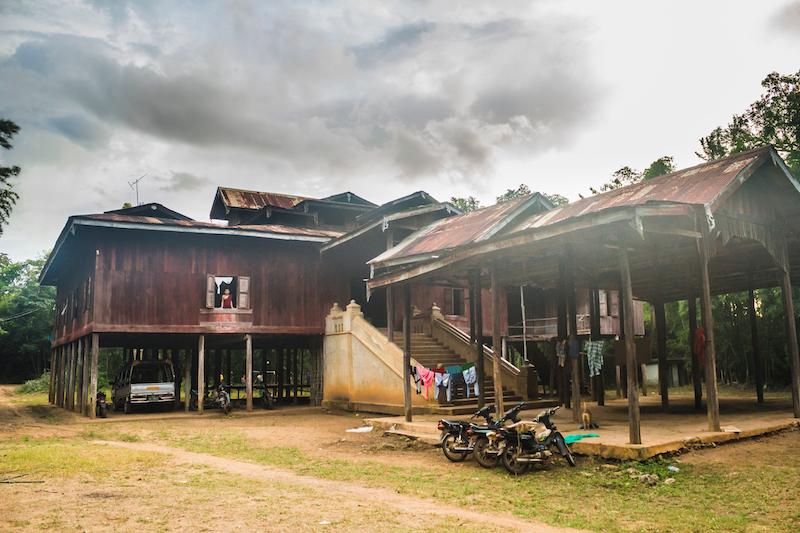
We didn’t enter inside the monastery but curious monks came to the windows to check us out as we walked around the outside. Two older monks appeared at one window and a young boy was looking down at us from another.
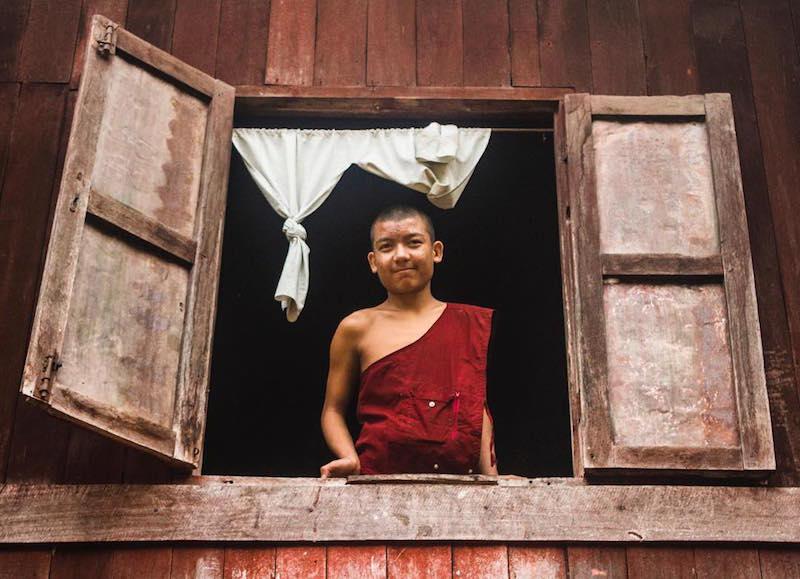
This place was pretty interesting for a quick stop but definitely not a must-see by any means. We recommend that you check out the forest monastery near Maing Thauk and then if you're still hungry for more you can check out one or two of the more secluded ones.
Returning back to Nyaungshwe on our bicycles that evening, an amazing rainbow appeared over the mountains off to the east. We rarely see perfect rainbows like this in Southeast Asia so we got pretty excited about it:

And then there was a magnificent sunset unfolding off to the west beyond the cornfields. It was the perfect ending to a perfect day cycling around Inle lake.
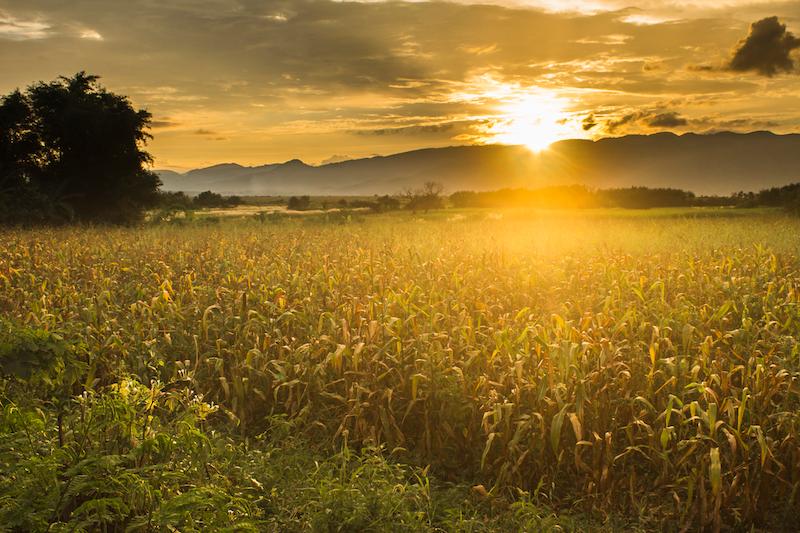
5. Explore the local monasteries in Nyaungshwe
There are several interesting pagodas around Nyaungshwe town itself. Perhaps the most notable pagoda is Shwe Yan Pyay one found about 2km north of the town near the first junction. It's a red-painted teak monastery that was built in the 19th century and is a favourite subject of photographers due to its attractive oval-shaped windows and of course, the resident monks.
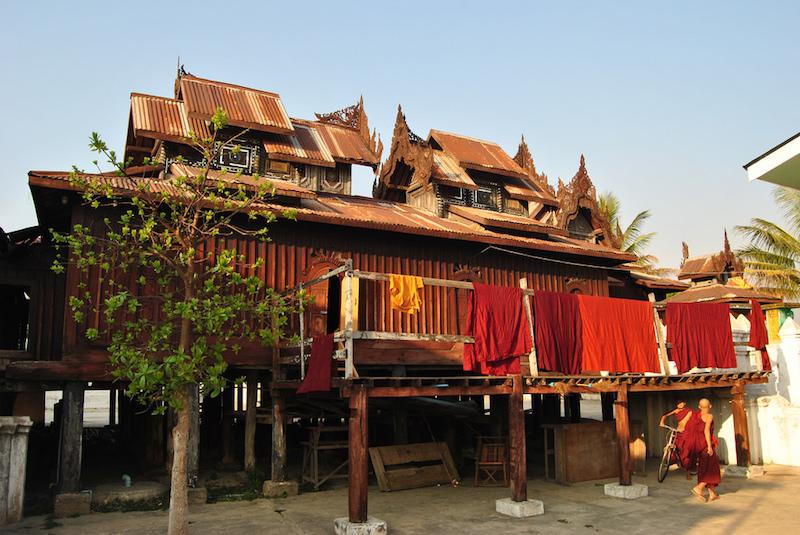
Yadana Man Aung Paya, found just a few hundred metres south of Mingalar Market,is the oldest and most important pagoda in Nyaungshwe.
It has an interesting stepped octagonal stupa, a design that's unique in Myanmar and the surrounding pavilion houses a collection of treasures including lacquerware, dance costumes and carvings.
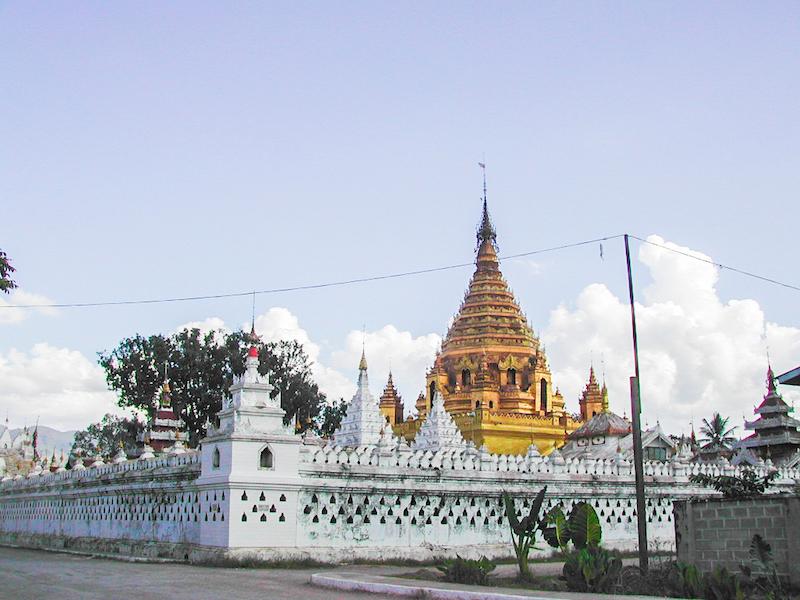
Cycling east out of the town on our way to Htat Eian cave temple we passed by the spectacular golden stupas of the Nigyon Taungyon monastery, a fabulous sight to behold.

Other things to do at Inle Lake
Even though this article provides a lot of information, it still only scratches the surface of Inle lake. Everyone has such different experiences when they visit the lake, especially when it comes to the boat trips, because there are so many different monasteries, workshops, markets and villages on the lake that one could potentially visit.
For example, we saw a silversmith workshop but there are also blacksmith, goldsmith, lotus weaving, silk weaving, cotton weaving, cheroot cigar making and other types of workshops that we didn’t get a chance to see - maybe next time.
There is a hot springs at a resort found on the Inle Lake west corridor road near Khaung Daing village to the northwest of Inle Lake. However, we wouldn’t recommend them unless you’re really desperate to bathe in the 40°C water, which is piped from the real hot springs into three tiny, unattractive man-made pools.
They certainly aren’t the natural hot springs you might find in Iceland or elsewhere. The resort also reportedly charges a ridiculous entry fee of $10 to use the facility. Probably best to steer clear of this one.
Trekking in the surrounding hills is another possibility although for this you might want to hire a local guide as it's supposedly illegal to go without one and there's a good possibility of getting lost. It's also possible to trek from Inle lake to Kalaw, although most people do it from Kalaw to Inle.
Your best bet for organizing a trek is to get in touch with one of the numerous little travel agencies in Nyaung Shwe and get them to hook you up with a guide for a day-long or multi-day trek.
The lake also has an interesting local market that rotates daily between several different sites, so that a full cycle is completed every five days. Many varieties of vegetables are sold at the market in addition to all kinds of handicraft and objects of souvenir potential.
There are about 14 different villages the market could potentially appear at on any given day, such as Nyaung Shwe, Heho, Taunggyi, Maing Thauk, Shwe Nyaung and Nam Pan villages just to name a few. The local people know the schedule better than anybody so ask around to find out where the market is going to be on any given day.
Watch video:
Recommended Guidebook: Lonely Planet Myanmar
Inspired to visit Inle Lake yet? Or perhaps you've already been? If you've been to Inle Lake we'd love to hear about your experience there. Leave us a comment below.
JOIN OUR LIST
SUPPORT US
FOLLOW US
ABOUT US
Our names are Eoghan and Jili and we hail from Ireland and India respectively.
We are two ardent shoestring budget adventure travellers and have been travelling throughout Asia continuously for the past few years.
Having accrued such a wealth of stories and knowledge from our extraordinary and transformative journey, our mission is now to share everything we've experienced and all of the lessons we've learned with our readers.
Do make sure to subscribe above in order to receive our free e-mail updates and exclusive travel tips & hints. If you would like to learn more about our story, philosophy and mission, please visit our about page.
Never stop travelling!
FOLLOW US ON FACEBOOK
FOLLOW US ON PINTEREST
-lw-scaled.png.png)


